This is a list of the bird species of India and includes
extant
Extant is the opposite of the word extinct. It may refer to:
* Extant hereditary titles
* Extant literature, surviving literature, such as ''Beowulf'', the oldest extant manuscript written in English
* Extant taxon, a taxon which is not extinct, ...
and recently extinct species recorded within the political limits of the Republic of
India
India, officially the Republic of India (Hindi: ), is a country in South Asia. It is the seventh-largest country by area, the second-most populous country, and the most populous democracy in the world. Bounded by the Indian Ocean on the so ...
as defined by the Indian government are known to have 1364 species as of 2021,
of which 81 are
endemic
Endemism is the state of a species being found in a single defined geographic location, such as an island, state, nation, country or other defined zone; organisms that are indigenous to a place are not endemic to it if they are also found elsew ...
to the country.
212 species are globally threatened. The
Indian peafowl
The Indian peafowl (''Pavo cristatus''), also known as the common peafowl, and blue peafowl, is a peafowl species native to the Indian subcontinent. It has been introduced to many other countries. Male peafowl are referred to as peacocks, and ...
(''Pavo cristatus'') is the national bird of India. This list does not cover species in Indian jurisdiction areas such as
Dakshin Gangotri
Dakshin Gangotri was the first scientific base station of India situated in Antarctica, part of the Indian Antarctic Programme. It is located at a distance of from the South Pole. It is currently being used as a supply base and transit camp. T ...
and oceanic species are delineated by an arbitrary cutoff distance. The list does not include fossil bird species or escapees from captivity.
This list's
taxonomic
Taxonomy is the practice and science of categorization or classification.
A taxonomy (or taxonomical classification) is a scheme of classification, especially a hierarchical classification, in which things are organized into groups or types. ...
treatment (designation and sequence of orders, families and species) and nomenclature (common and scientific names) follow the conventions of the IOC World Bird List, version 11.2. This list also uses British English throughout. Any bird names or other wording follows that convention.
The following tags have been used to highlight several categories. The commonly occurring native species do not fit within any of these categories.
*(V)
Vagrant
Vagrancy is the condition of homelessness without regular employment or income. Vagrants (also known as bums, vagabonds, rogues, tramps or drifters) usually live in poverty and support themselves by begging, scavenging, petty theft, temporar ...
- Also known as a rarity, it refers to a species that rarely or accidentally occurs in India-typically less than ten confirmed records.
*(E)
Endemic
Endemism is the state of a species being found in a single defined geographic location, such as an island, state, nation, country or other defined zone; organisms that are indigenous to a place are not endemic to it if they are also found elsew ...
- a species endemic to India
*(Ex)
Extirpated
Local extinction, also known as extirpation, refers to a species (or other taxon) of plant or animal that ceases to exist in a chosen geographic area of study, though it still exists elsewhere. Local extinctions are contrasted with global extinct ...
- a species that no longer occurs in India although populations exist elsewhere
Ducks, geese and swans
Order:
Anseriformes
Anseriformes is an order of birds also known as waterfowl that comprises about 180 living species of birds in three families: Anhimidae (three species of screamers), Anseranatidae (the magpie goose), and Anatidae, the largest family, which in ...
Family:
Anatidae
The Anatidae are the biological family of water birds that includes ducks, geese, and swans. The family has a cosmopolitan distribution, occurring on all the world's continents except Antarctica. These birds are adapted for swimming, floating ...
Anatidae includes the
duck
Duck is the common name for numerous species of waterfowl in the family Anatidae. Ducks are generally smaller and shorter-necked than swans and geese, which are members of the same family. Divided among several subfamilies, they are a form t ...
s and most duck-like waterfowl, such as
geese
A goose (plural, : geese) is a bird of any of several waterfowl species in the family (biology), family Anatidae. This group comprises the genera ''Anser (bird), Anser'' (the grey geese and white geese) and ''Branta'' (the black geese). Some o ...
and
swan
Swans are birds of the family (biology), family Anatidae within the genus ''Cygnus''. The swans' closest relatives include the goose, geese and ducks. Swans are grouped with the closely related geese in the subfamily Anserinae where they form t ...
s. These birds are adapted to an aquatic existence with webbed feet, flattened bills, and feathers that are excellent at shedding water due to an oily coating. There are 45 species which have been recorded in India.
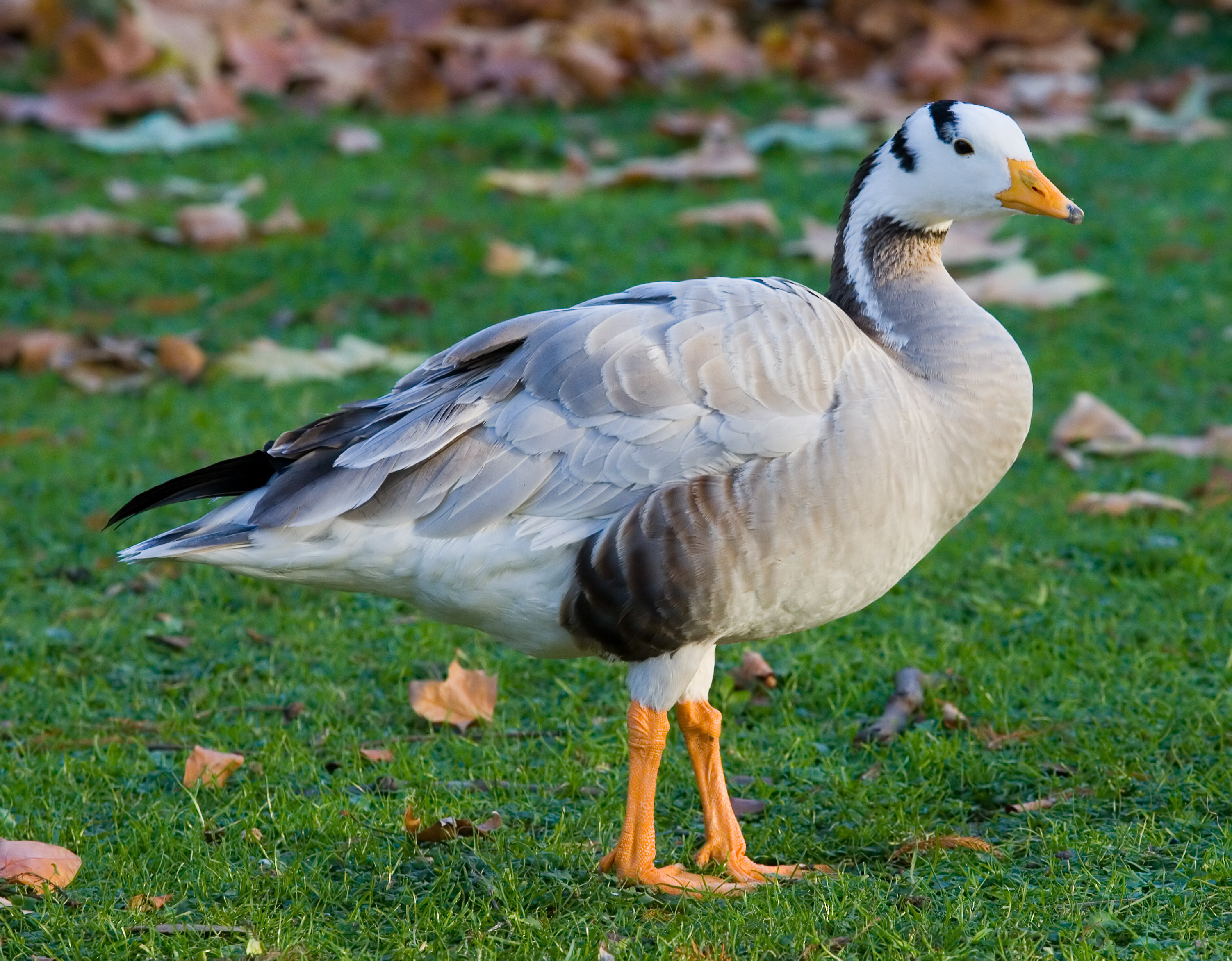


Megapodes
Order:
Galliformes
Galliformes is an order of heavy-bodied ground-feeding birds that includes turkeys, chickens, quail, and other landfowl. Gallinaceous birds, as they are called, are important in their ecosystems as seed dispersers and predators, and are often ...
Family:
Megapodiidae
The megapodes, also known as incubator birds or mound-builders, are stocky, medium-large, chicken-like birds with small heads and large feet in the family Megapodiidae. Their name literally means "large foot" and is a reference to the heavy legs ...
The Megapodiidae are stocky, medium-large chicken-like birds with small heads and large feet. All but the
malleefowl
The malleefowl (''Leipoa ocellata'') is a stocky ground-dwelling Australian bird about the size of a domestic chicken (to which it is distantly related). It is notable for the large nesting mounds constructed by the males and lack of parental ca ...
occupy jungle habitats and most have brown or black colouring. There is one species within India.
Pheasants and allies
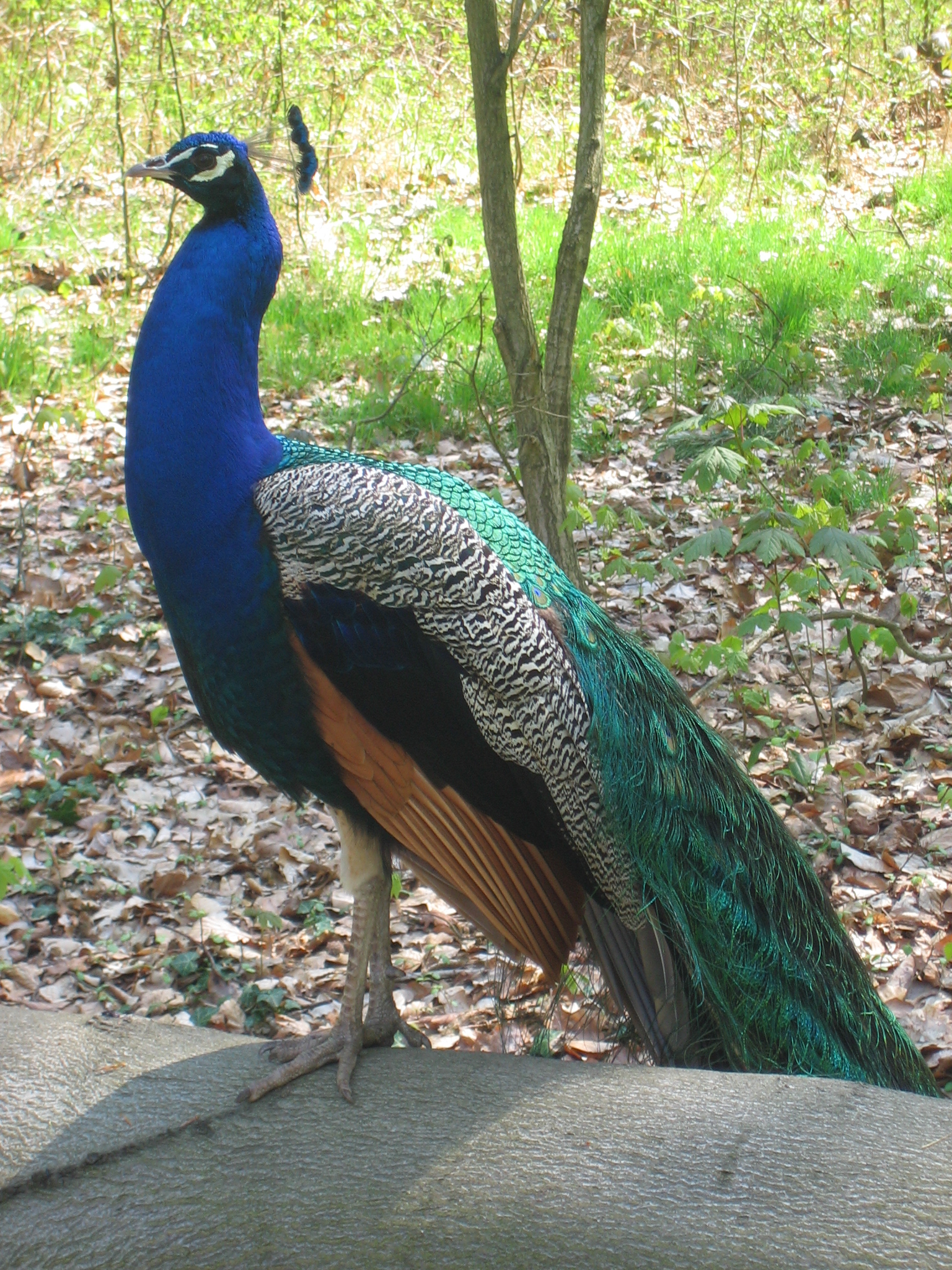

Order:
Galliformes
Galliformes is an order of heavy-bodied ground-feeding birds that includes turkeys, chickens, quail, and other landfowl. Gallinaceous birds, as they are called, are important in their ecosystems as seed dispersers and predators, and are often ...
Family:
Phasianidae
The Phasianidae are a family (biology), family of heavy, ground-living birds, which includes pheasants, partridges, junglefowl, chickens, Turkey bird, turkeys, Old World quail, and peafowl. The family includes many of the most popular Game (hunti ...


The Phasianidae are a family of terrestrial birds which consists of
quail
Quail is a collective name for several genera of mid-sized birds generally placed in the order Galliformes. The collective noun for a group of quail is a flock, covey, or bevy.
Old World quail are placed in the family Phasianidae, and New Wor ...
s,
partridge
A partridge is a medium-sized Galliformes, galliform bird in any of several genera, with a wide Indigenous (ecology), native distribution throughout parts of Europe, Asia and Africa. Several species have been introduced to the Americas. They a ...
s,
snowcock
The snowcocks or snowfowl are a group of bird species in the genus ''Tetraogallus'' of the pheasant family, Phasianidae. They are ground-nesting birds that breed in the mountain ranges of southern Eurasia from the Caucasus to the Himalayas and we ...
s,
francolin
Francolins are birds in the tribe Gallini that traditionally have been placed in the genus ''Francolinus'', but now commonly are divided into multiple genera.
As previously defined, they were paraphyletic as the genus ''Pternistis'', which was ...
s, spurfowl,
tragopan
''Tragopan'' is a bird genus in the pheasant family Phasianidae. Member of the genus are commonly called "horned pheasants" because males have two brightly colored, fleshy horns on their head that can be erected during courtship displays. The ha ...
s,
monal
A monal is a bird of genus ''Lophophorus'' of the pheasant family, Phasianidae. Description
The males all have colorful, iridescent plumage. Their physique is rather plump. Their diet consists of plants such as roots and bulbs and insects. D ...
s,
pheasant
Pheasants ( ) are birds of several genera within the family (biology), family Phasianidae in the order (biology), order Galliformes. Although they can be found all over the world in introduced (and captive) populations, the pheasant genera na ...
s,
peafowl
Peafowl is a common name for three bird species in the genera '' Pavo'' and ''Afropavo'' within the tribe Pavonini of the family Phasianidae, the pheasants and their allies. Male peafowl are referred to as peacocks, and female peafowl are refe ...
s and
jungle fowl
Junglefowl are the only four living species of bird from the genus ''Gallus'' in the bird order Galliformes, and occur in parts of South and Southeast Asia. They diverged from their common ancestor about 4–6 million years ago.
Although origin ...
s. In general, they are plump (although they vary in size) and have broad, relatively short wings.
Frogmouths
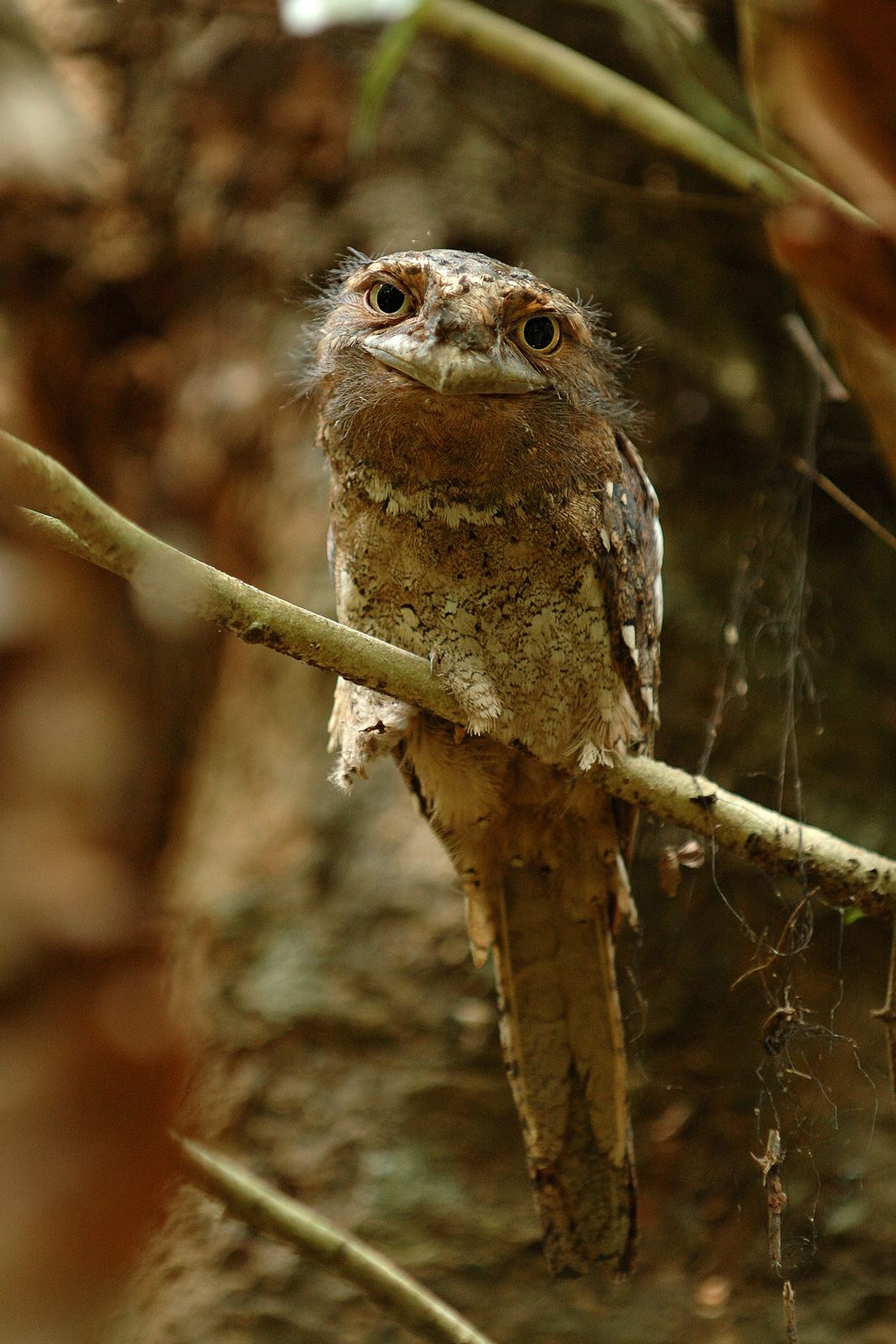
Order:
Podargiformes Vertebrates
Vertebrates () comprise all animal taxa within the subphylum Vertebrata () (chordates with backbones), including all mammals, birds, reptiles, amphibians, and fish. Vertebrates represent the overwhelming majority of the phylum Cho ...
Family:
Podargidae
The frogmouths are a group of nocturnal birds related to the
nightjar
Nightjars are medium-sized nocturnal or crepuscular birds in the family Caprimulgidae and order Caprimulgiformes, characterised by long wings, short legs, and very short bills. They are sometimes called goatsuckers, due to the ancient folk ta ...
s. They are named for their large flattened hooked bill and huge frog-like gape, which they use to take insects. There are two species which have been recorded in India.
Nightjars
Order:
Caprimulgiformes
Nightjars are medium-sized nocturnal or crepuscular birds in the family Caprimulgidae and order Caprimulgiformes, characterised by long wings, short legs, and very short bills. They are sometimes called goatsuckers, due to the ancient folk tal ...
Family:
Caprimulgidae
Nightjar
Nightjars are medium-sized nocturnal or crepuscular birds in the family Caprimulgidae and order Caprimulgiformes, characterised by long wings, short legs, and very short bills. They are sometimes called goatsuckers, due to the ancient folk ta ...
s are medium-sized nocturnal birds that usually nest on the ground. They have long wings, short legs and very short bills. Most have small feet, of little use for walking, and long pointed wings. Their soft plumage is camouflaged to resemble bark or leaves.

Treeswifts

Order:
Apodiformes
Traditionally, the bird order Apodiformes contained three living families: the swifts (Apodidae), the treeswifts (Hemiprocnidae), and the hummingbirds (Trochilidae). In the Sibley-Ahlquist taxonomy, this order is raised to a superorder Apodi ...
Family:
Hemiprocnidae
The treeswifts, or crested swifts, are closely related to the
true swifts. They differ from the other swifts in that they have crests, long forked tails and softer plumage. There is one species which occurs in India.
Swifts

Order:
Apodiformes
Traditionally, the bird order Apodiformes contained three living families: the swifts (Apodidae), the treeswifts (Hemiprocnidae), and the hummingbirds (Trochilidae). In the Sibley-Ahlquist taxonomy, this order is raised to a superorder Apodi ...
Family:
Apodidae
The swifts are a family, Apodidae, of highly aerial birds. They are superficially similar to swallows, but are not closely related to any passerine species. Swifts are placed in the order Apodiformes with hummingbirds. The treeswifts are closely r ...
Swift
Swift or SWIFT most commonly refers to:
* SWIFT, an international organization facilitating transactions between banks
** SWIFT code
* Swift (programming language)
* Swift (bird), a family of birds
It may also refer to:
Organizations
* SWIFT, ...
s are small birds which spend the majority of their lives flying. These birds have very short legs and never settle voluntarily on the ground, perching instead only on vertical surfaces. Many swifts have long swept-back wings which resemble a crescent or boomerang. There are 16 species which have been recorded in India.

Bustards

Order:
OtidiformesFamily:
Otididae
Bustards, including floricans and korhaans, are large, terrestrial birds living mainly in dry grassland areas and on the steppes of the Old World. They range in length from . They make up the family Otididae (, formerly known as Otidae). Bustards ...
Bustards are large terrestrial birds mainly associated with dry open country and steppes in the Old World. They are omnivorous and nest on the ground. They walk steadily on strong legs and big toes, pecking for food as they go. They have long broad wings with "fingered" wingtips and striking patterns in flight. Many have interesting mating displays.
Cuckoos
Order:
Cuculiformes
Cuckoos are birds in the Cuculidae family, the sole taxon in the order Cuculiformes . The cuckoo family includes the common or European cuckoo, roadrunners, koels, malkohas, couas, coucals and anis. The coucals and anis are sometimes separa ...
Family:
Cuculidae
Cuckoos are birds in the Cuculidae family, the sole taxon in the order Cuculiformes . The cuckoo family includes the common or European cuckoo, roadrunners, koels, malkohas, couas, coucals and anis. The coucals and anis are sometimes separ ...
The family Cuculidae includes
cuckoo
Cuckoos are birds in the Cuculidae family, the sole taxon in the order Cuculiformes . The cuckoo family includes the common or European cuckoo, roadrunners, koels, malkohas, couas, coucals and anis. The coucals and anis are sometimes separ ...
s,
roadrunner
The roadrunners (genus ''Geococcyx''), also known as chaparral birds or chaparral cocks, are two species of fast-running ground cuckoos with long tails and crests. They are found in the southwestern and south-central United States and Mexico, us ...
s and
anis. These birds are of variable size with slender bodies, long tails and strong legs. Many are
brood parasite
Brood parasites are animals that rely on others to raise their young. The strategy appears among birds, insects and fish. The brood parasite manipulates a host, either of the same or of another species, to raise its young as if it were its own ...
s. There are 24 species which have been recorded in India.


Sandgrouse

Order:
Pterocliformes
Sandgrouse is the common name for Pteroclidae , a family of sixteen species of bird, members of the order Pterocliformes . They are traditionally placed in two genera. The two central Asian species are classified as '' Syrrhaptes'' and the othe ...
Family:
Pteroclidae
Sandgrouse is the common name for Pteroclidae , a family of sixteen species of bird, members of the order Pterocliformes . They are traditionally placed in two genera. The two central Asian species are classified as '' Syrrhaptes'' and the other ...
Sandgrouse have small, pigeon like heads and necks, but sturdy compact bodies. They have long pointed wings and sometimes tails and a fast direct flight. Flocks fly to watering holes at dawn and dusk. Their legs are feathered down to the toes. There are seven species which have been recorded in India. India has the largest number of sandgrouse of any country.
Pigeons and doves

Order:
Columbiformes
Columbidae () is a bird family consisting of doves and pigeons. It is the only family in the order Columbiformes. These are stout-bodied birds with short necks and short slender bills that in some species feature fleshy ceres. They primarily ...
Family:
Columbidae
Columbidae () is a bird family consisting of doves and pigeons. It is the only family in the order Columbiformes. These are stout-bodied birds with short necks and short slender bills that in some species feature fleshy ceres. They primarily ...
Pigeon
Columbidae () is a bird family consisting of doves and pigeons. It is the only family in the order Columbiformes. These are stout-bodied birds with short necks and short slender bills that in some species feature fleshy ceres. They primarily ...
s and
dove
Columbidae () is a bird family consisting of doves and pigeons. It is the only family in the order Columbiformes. These are stout-bodied birds with short necks and short slender bills that in some species feature fleshy ceres. They primarily ...
s are stout-bodied birds with short necks and short slender bills with a fleshy
cere
The beak, bill, or rostrum is an external anatomical structure found mostly in birds, but also in turtles, non-avian dinosaurs and a few mammals. A beak is used for eating, preening, manipulating objects, killing prey, fighting, probing for food, ...
.


Finfoots
Order:
Gruiformes
The Gruiformes are an order (biology), order containing a considerable number of living and extinct bird family (biology), families, with a widespread geographical diversity. Gruiform means "crane-like".
Traditionally, a number of wading and t ...
Family:
Heliornithidae
The Heliornithidae are a small family of tropical birds with webbed lobes on their feet like those of grebes and coots. The family overall are known as finfoots, although one species is known as a sungrebe. The family is composed of three speci ...
Heliornithidae is a small family of tropical birds with webbed lobes on their feet similar to those of grebes and coots. There is one species which occurs in India.
Rails, crakes, and coots

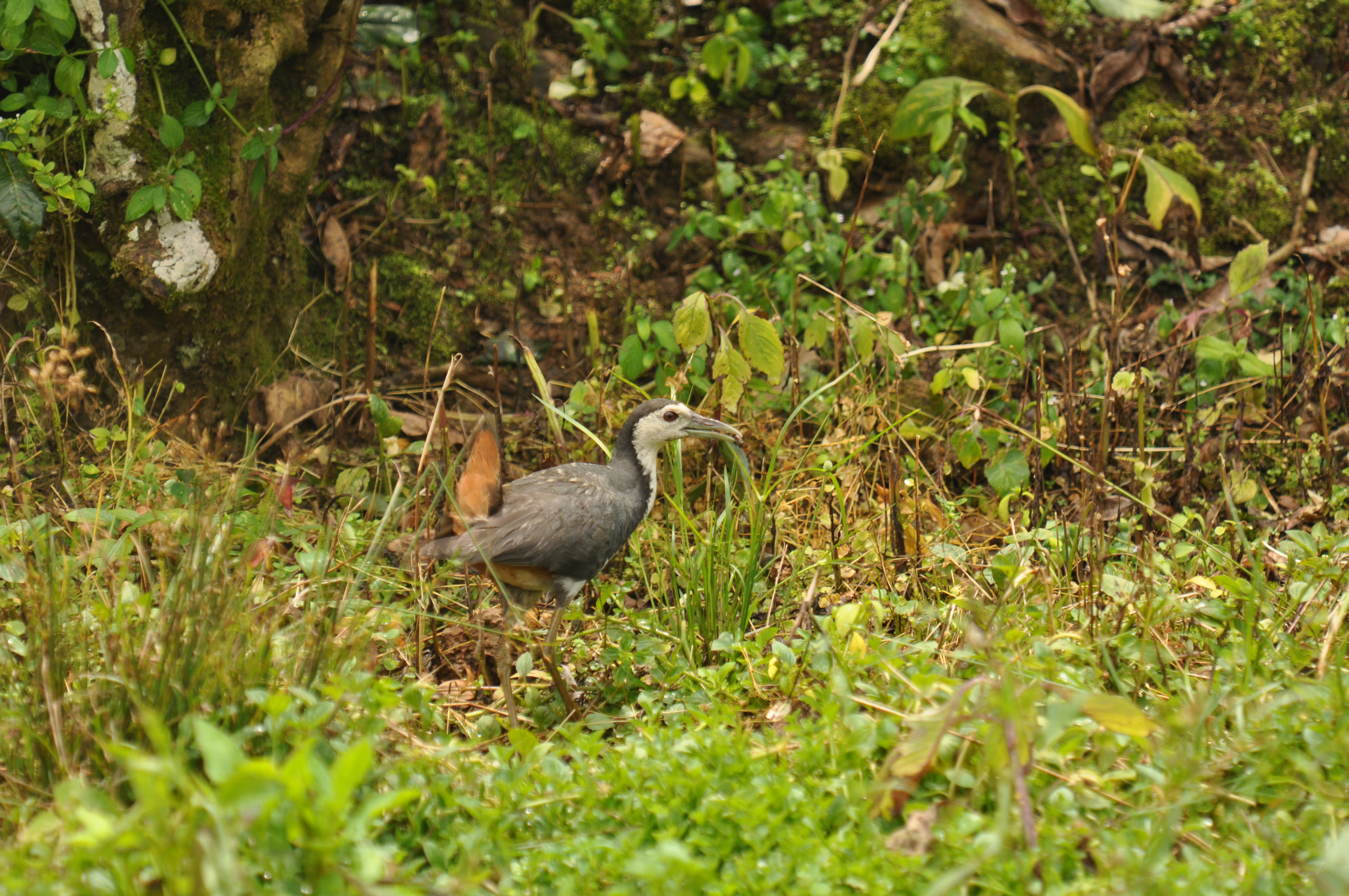
Order:
Gruiformes
The Gruiformes are an order (biology), order containing a considerable number of living and extinct bird family (biology), families, with a widespread geographical diversity. Gruiform means "crane-like".
Traditionally, a number of wading and t ...
Family:
Rallidae
The rails, or Rallidae, are a large cosmopolitan family of small- to medium-sized, ground-living birds. The family exhibits considerable diversity and includes the crakes, coots, and gallinules. Many species are associated with wetlands, althoug ...
Rallidae is a large family of small to medium-sized birds which includes the
rails
Rail or rails may refer to:
Rail transport
*Rail transport and related matters
*Rail (rail transport) or railway lines, the running surface of a railway
Arts and media Film
* ''Rails'' (film), a 1929 Italian film by Mario Camerini
* ''Rail'' ( ...
,
crake
The rails, or Rallidae, are a large cosmopolitan family of small- to medium-sized, ground-living birds. The family exhibits considerable diversity and includes the crakes, coots, and gallinules. Many species are associated with wetlands, althoug ...
s,
coot
Coots are medium-sized water birds that are members of the rail family, Rallidae. They constitute the genus ''Fulica'', the name being the Latin term for "coot". Coots have predominantly black plumage, and—unlike many rails—they are usually ...
s and
gallinule
Moorhens—sometimes called marsh hens—are medium-sized water birds that are members of the rail family (Rallidae). Most species are placed in the genus ''Gallinula'', Latin for "little hen".
They are close relatives of coots. They are of ...
s. Typically they inhabit dense vegetation in damp environments near lakes, swamps or rivers. In general they are shy and secretive birds, making them difficult to observe. Most species have strong legs and long toes which are well adapted to soft uneven surfaces. They tend to have short, rounded wings and to be weak fliers.

Cranes
Order:
Gruiformes
The Gruiformes are an order (biology), order containing a considerable number of living and extinct bird family (biology), families, with a widespread geographical diversity. Gruiform means "crane-like".
Traditionally, a number of wading and t ...
Family:
Gruidae
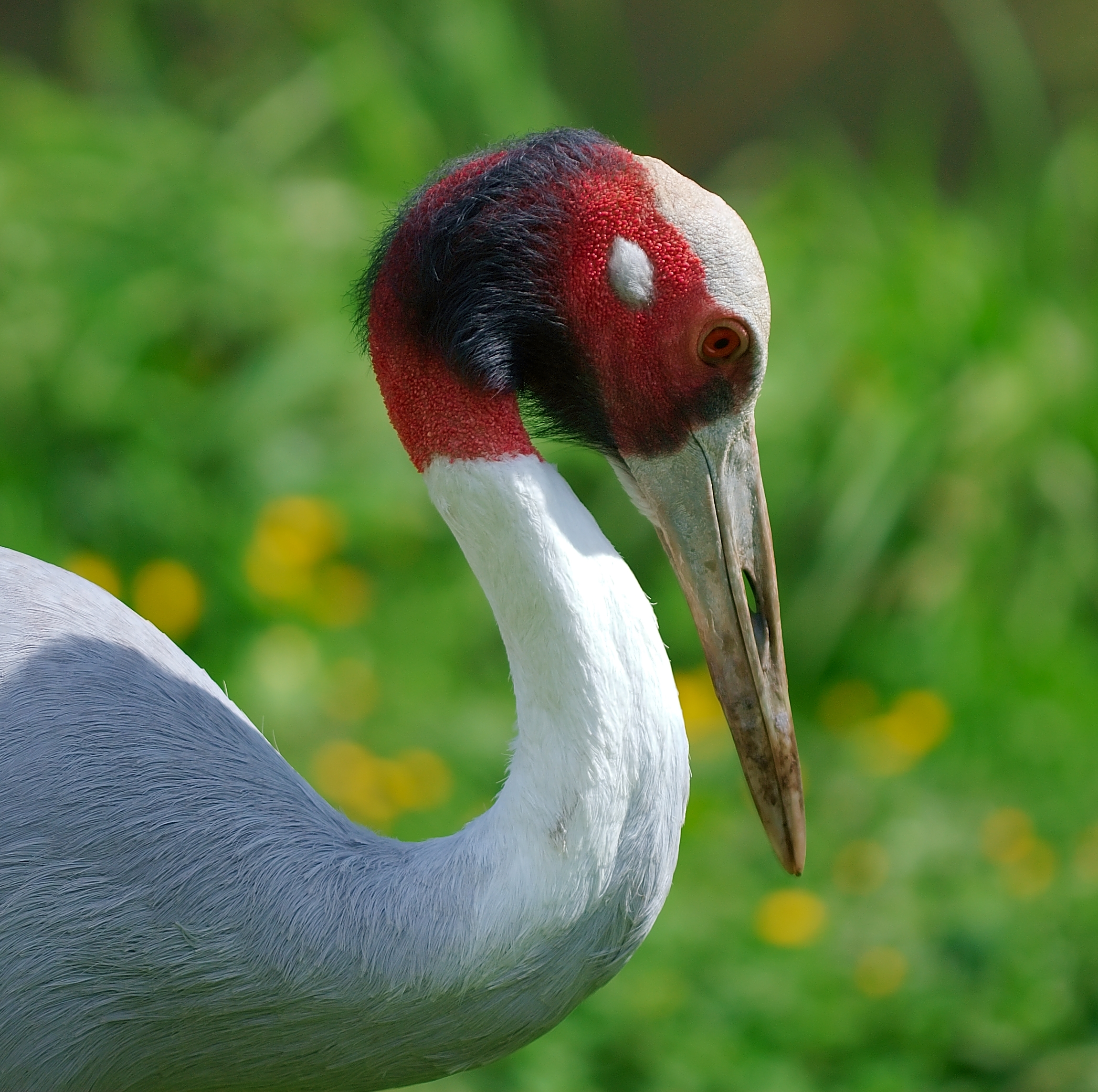
Cranes are large, long-legged and long-necked birds. Unlike the similar-looking but unrelated herons, cranes fly with necks outstretched, not pulled back. Most have elaborate and noisy courting displays or "dances". There are five species which have been recorded in India.
The
hooded crane
The hooded crane (''Grus monacha'') is a crane native to East Asia and a frequent migratory bird in Japan.
Description
It has a grey body. The top of the neck and head is white, except for a patch of bare red skin above the eye. It is one of t ...
, ''Grus monacha,'' was included in many older lists but is considered hypothetical (Rasmussen and Anderton, 2005) or even extirpated
[BirdLife International. 2016. Grus monacha. The IUCN Red List of Threatened Species 2016: e.T22692151A93337861. https://dx.doi.org/10.2305/IUCN.UK.2016-3.RLTS.T22692151A93337861.en. Downloaded on 03 April 2021.] by more recent workers.
Grebes

Order:
PodicipediformesFamily:
Podicipedidae
Grebe
Grebes () are aquatic diving birds in the order Podicipediformes . Grebes are widely distributed freshwater birds, with some species also found in marine habitats during migration and winter. Some flightless species exist as well, most notably ...
s are small to medium-large freshwater diving birds. They have lobed toes and are excellent swimmers and divers. However, they have their feet placed far back on the body, making them quite ungainly on land. There are five species which have been recorded in India.
Flamingos

Order:
Phoenicopteriformes
Phoenicopteriformes is a group of water birds which comprises flamingos and their extinct relatives. Flamingos (Phoenicopteriformes) and the closely related grebes ( Podicipedidae) are contained in the parent clade Mirandornithes.
Fossil rec ...
Family:
Phoenicopteridae
Flamingos or flamingoes are a type of wading bird in the family Phoenicopteridae, which is the only extant family in the order Phoenicopteriformes. There are four flamingo species distributed throughout the Americas (including the Caribbean) ...
Flamingo
Flamingos or flamingoes are a type of Wader, wading bird in the Family (biology), family Phoenicopteridae, which is the only extant family in the order Phoenicopteriformes. There are four flamingo species distributed throughout the Americas ...
s are gregarious wading birds, usually tall, found in both the Western and Eastern Hemispheres. Flamingos filter-feed on shellfish and algae. Their oddly shaped beaks are specially adapted to separate mud and silt from the food they consume and, uniquely, are used upside-down. There are two species which have been recorded in India.
Buttonquail
Order:
Charadriiformes
Charadriiformes (, from ''Charadrius'', the type genus of family Charadriidae) is a diverse order of small to medium-large birds. It includes about 390 species and has members in all parts of the world. Most charadriiform birds live near water an ...
Family:
Turnicidae
Buttonquail or hemipodes are members of a small family of birds, Turnicidae, which resemble, but are unrelated to, the quails of Phasianidae. They inhabit warm grasslands in Asia, Africa, Europe, and Australia. There are 18 species in two genera ...
The buttonquail are small, drab, running birds which resemble the true quails. The female is the brighter of the sexes and initiates courtship. The male incubates the eggs and tends the young. There are three species which have been recorded in India.
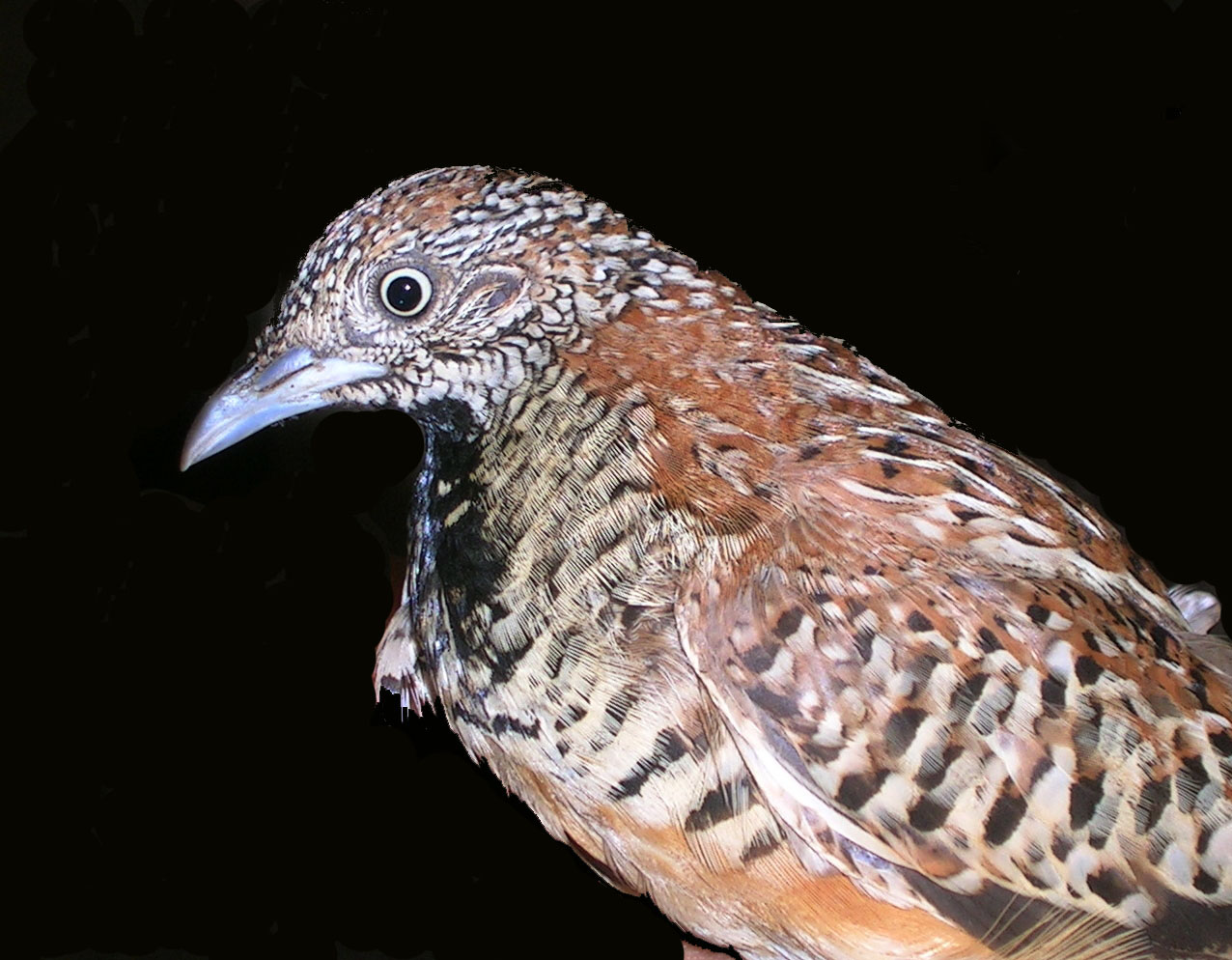
Stone-curlews and thick-knees
Order:
Charadriiformes
Charadriiformes (, from ''Charadrius'', the type genus of family Charadriidae) is a diverse order of small to medium-large birds. It includes about 390 species and has members in all parts of the world. Most charadriiform birds live near water an ...
Family:
Burhinidae
The stone-curlews, also known as dikkops or thick-knees, consist of 10 species within the family Burhinidae, and are found throughout the tropical and temperate parts of the world, with two or more species occurring in some areas of Africa, Asia, ...

Stone-curlews are a group of largely tropical waders in the family Burhinidae. They are found worldwide within the tropical zone, with some species also breeding in temperate Europe and Australia. They are medium to large waders with strong black or yellow-black bills, large yellow eyes and
cryptic
Cryptic may refer to:
In science:
* Cryptic species complex, a group of species that are very difficult to distinguish from one another
* Crypsis, the ability of animals to blend in to avoid observation
* Cryptic era, earliest period of the Earth
...
plumage. Despite being classed as waders, most species have a preference for arid or semi-arid habitats.
Oystercatchers

Order:
Charadriiformes
Charadriiformes (, from ''Charadrius'', the type genus of family Charadriidae) is a diverse order of small to medium-large birds. It includes about 390 species and has members in all parts of the world. Most charadriiform birds live near water an ...
Family:
Haematopodidae
The
oystercatcher
The oystercatchers are a group of waders forming the family Haematopodidae, which has a single genus, ''Haematopus''. They are found on coasts worldwide apart from the polar regions and some tropical regions of Africa and South East Asia. The e ...
s are large and noisy
plover
Plovers ( , ) are a widely distributed group of wading birds belonging to the subfamily Charadriinae.
Description
There are about 66 species in the subfamily, most of them called "plover" or "dotterel". The closely related lapwing subfa ...
-like birds, with strong bills used for smashing or prising open
mollusc
Mollusca is the second-largest phylum of invertebrate animals after the Arthropoda, the members of which are known as molluscs or mollusks (). Around 85,000 extant species of molluscs are recognized. The number of fossil species is esti ...
s. There is one species which occurs in India.
Ibisbill

Order:
Charadriiformes
Charadriiformes (, from ''Charadrius'', the type genus of family Charadriidae) is a diverse order of small to medium-large birds. It includes about 390 species and has members in all parts of the world. Most charadriiform birds live near water an ...
Family:
Ibidorhynchidae
The ibisbill (''Ibidorhyncha struthersii'') is a bird related to the waders, but sufficiently distinctive to merit its own family Ibidorhynchidae. It is grey with a white belly, red legs and long down-curved bill, and a black face and black breas ...
The ibisbill is related to the
wader
245px, A flock of Dunlins and Red knots">Red_knot.html" ;"title="Dunlins and Red knot">Dunlins and Red knots
Waders or shorebirds are birds of the order Charadriiformes commonly found wikt:wade#Etymology 1, wading along shorelines and mudflat ...
s, but is sufficiently distinctive to be a family unto itself. The adult is grey with a white belly, red legs, a long down curved bill, and a black face and breast band.
Stilts and avocets
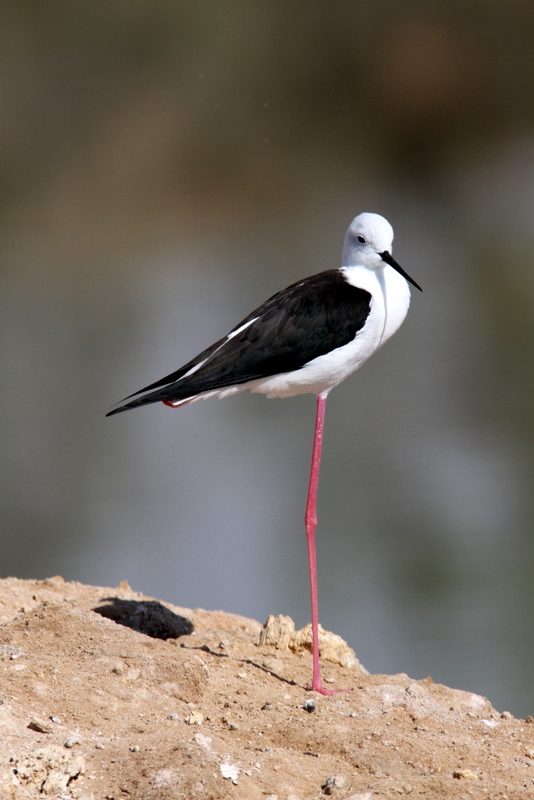
Order:
Charadriiformes
Charadriiformes (, from ''Charadrius'', the type genus of family Charadriidae) is a diverse order of small to medium-large birds. It includes about 390 species and has members in all parts of the world. Most charadriiform birds live near water an ...
Family:
Recurvirostridae
The Recurvirostridae are a family of birds in the wader suborder Charadrii. It contains two distinct groups of birds, the avocets (one genus) and the stilts (two genera).
Description
Avocets and stilts range in length from and in weight from ; ...
Recurvirostridae is a family of large wading birds, which includes the
avocet
The four species of avocets are a genus, ''Recurvirostra'', of waders in the same avian family as the stilts. The genus name comes from Latin , 'curved backwards' and , 'bill'. The common name is thought to derive from the Italian ( Ferrarese) w ...
s and
stilt
Stilt is a common name for several species of birds in the family Recurvirostridae, which also includes those known as avocets. They are found in brackish or saline wetlands in warm or hot climates.
They have extremely long legs, hence the grou ...
s. The avocets have long legs and long up-curved bills. The stilts have extremely long legs and long, thin, straight bills. There are two species which have been recorded in India.
Plovers

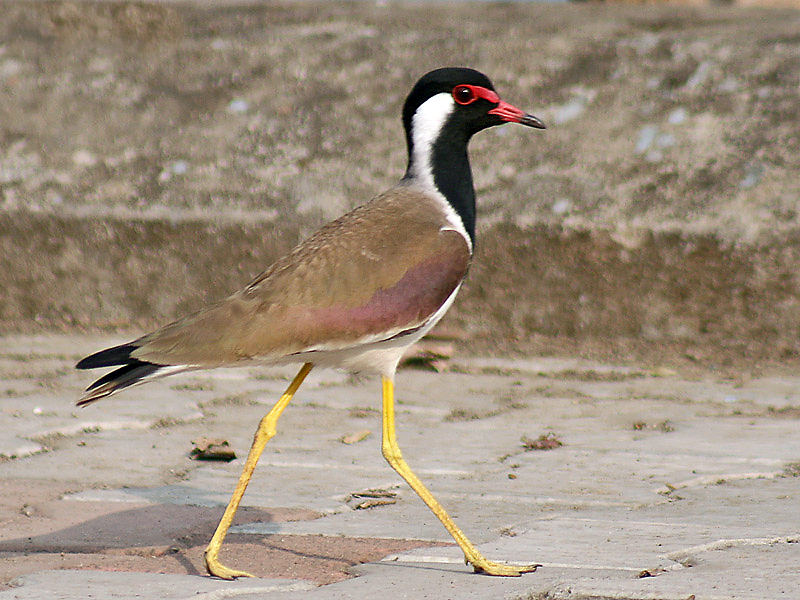
Order:
Charadriiformes
Charadriiformes (, from ''Charadrius'', the type genus of family Charadriidae) is a diverse order of small to medium-large birds. It includes about 390 species and has members in all parts of the world. Most charadriiform birds live near water an ...
Family:
Charadriidae
The bird family Charadriidae includes the plovers, dotterels, and lapwings, about 64 to 68 species in all.
Taxonomy
The family Charadriidae was introduced (as Charadriadæ) by the English zoologist William Elford Leach in a guide to the conten ...
The family Charadriidae includes the
plover
Plovers ( , ) are a widely distributed group of wading birds belonging to the subfamily Charadriinae.
Description
There are about 66 species in the subfamily, most of them called "plover" or "dotterel". The closely related lapwing subfa ...
s,
dotterel
The Eurasian dotterel (''Charadrius morinellus''), also known in Europe as just dotterel, is a small wader in the plover family of birds.
The dotterel is a brown and black streaked bird with a broad white eye-stripe and an orange-red chest ban ...
s and
lapwing
Lapwings (subfamily Vanellinae) are any of various ground-nesting birds (family Charadriidae) akin to plovers and dotterels. They range from in length, and are noted for their slow, irregular wingbeats in flight and a shrill, wailing cry. A gro ...
s. They are small to medium-sized birds with compact bodies, short, thick necks and long, usually pointed, wings. They are found in open country worldwide, mostly in habitats near water. There are 20 species which have been recorded in India.
Painted-snipes

Order:
Charadriiformes
Charadriiformes (, from ''Charadrius'', the type genus of family Charadriidae) is a diverse order of small to medium-large birds. It includes about 390 species and has members in all parts of the world. Most charadriiform birds live near water an ...
Family:
Rostratulidae
The Rostratulidae, commonly known as the painted-snipes, are a family of wading birds that consists of two genera: ''Rostratula'' and '' Nycticryphes''.
Description
The painted-snipes are short-legged, long-billed birds similar in shape to the t ...
Painted-snipes are short-legged, long-billed birds similar in shape to the true snipes, but more brightly coloured. There is one species which occurs in India.
Jacanas
Order:
Charadriiformes
Charadriiformes (, from ''Charadrius'', the type genus of family Charadriidae) is a diverse order of small to medium-large birds. It includes about 390 species and has members in all parts of the world. Most charadriiform birds live near water an ...
Family:
Jacanidae
The jacanas (sometimes referred to as Jesus birds or lily trotters) are a group of tropical waders in the family Jacanidae. They are found in the tropical regions around the world. They are noted for their elongated toes and toenails that allow ...
The jacanas are a group of tropical waders in the family Jacanidae. They are found throughout the tropics. They are identifiable by their huge feet and claws which enable them to walk on floating vegetation in the shallow lakes that are their preferred habitat. There are two species which have been recorded in India.
Sandpipers and snipes
Order:
Charadriiformes
Charadriiformes (, from ''Charadrius'', the type genus of family Charadriidae) is a diverse order of small to medium-large birds. It includes about 390 species and has members in all parts of the world. Most charadriiform birds live near water an ...
Family:
Scolopacidae
Sandpipers are a large family, Scolopacidae, of waders. They include many species called sandpipers, as well as those called by names such as curlew and snipe. The majority of these species eat small invertebrates picked out of the mud or soil. ...
Scolopacidae is a large diverse family of small to medium-sized shorebirds including the
sandpiper
Sandpipers are a large family, Scolopacidae, of waders. They include many species called sandpipers, as well as those called by names such as curlew and snipe. The majority of these species eat small invertebrates picked out of the mud or soil. ...
s,
curlew
The curlews () are a group of nine species of birds in the genus ''Numenius'', characterised by their long, slender, downcurved bills and mottled brown plumage. The English name is imitative of the Eurasian curlew's call, but may have been in ...
s,
godwit
The godwits are a group of large, long-billed, long-legged and strongly migratory waders of the bird genus ''Limosa''. Their long bills allow them to probe deeply in the sand for aquatic worms and molluscs. In their winter range, they flock ...
s,
shanks,
tattlers,
woodcock
The woodcocks are a group of seven or eight very similar living species of wading birds in the genus ''Scolopax''. The genus name is Latin for a snipe or woodcock, and until around 1800 was used to refer to a variety of waders. The English name ...
s,
snipe
A snipe is any of about 26 wading bird species in three genera in the family Scolopacidae. They are characterized by a very long, slender bill, eyes placed high on the head, and cryptic/camouflaging plumage. The ''Gallinago'' snipes have a near ...
s,
dowitcher
The three dowitchers are medium-sized long-billed wading birds in the genus ''Limnodromus''. The English name "dowitchers" is from Iroquois, recorded in English by the 1830s. The OED's earliest example is from 1841, but full-text searching giv ...
s and
phalarope
__NOTOC__
A phalarope is any of three living species of slender-necked shorebirds in the genus ''Phalaropus'' of the bird family Scolopacidae.
Phalaropes are close relatives of the shanks and tattlers, the ''Actitis'' and Terek sandpipers, a ...
s. The majority of these species eat small invertebrates picked out of the mud or soil. Variation in length of legs and bills enables multiple species to feed in the same habitat, particularly on the coast, without direct competition for food. There are 41 species which have been recorded in India.



Crab-plover

Order:
Charadriiformes
Charadriiformes (, from ''Charadrius'', the type genus of family Charadriidae) is a diverse order of small to medium-large birds. It includes about 390 species and has members in all parts of the world. Most charadriiform birds live near water an ...
Family:
Dromadidae
The crab-plover or crab plover (''Dromas ardeola)'' is a bird related to the waders, but sufficiently distinctive to merit its own family Dromadidae. Its relationship within the Charadriiformes is unclear, some have considered it to be closely ...
The crab-plover is related to the waders. It resembles a plover but with very long grey legs and a strong heavy black bill similar to a tern. It has black-and-white plumage, a long neck, partially webbed feet and a bill designed for eating crabs.
Coursers and pratincoles
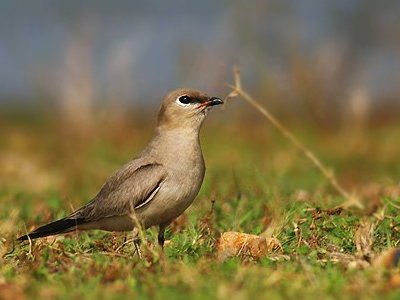
Order:
Charadriiformes
Charadriiformes (, from ''Charadrius'', the type genus of family Charadriidae) is a diverse order of small to medium-large birds. It includes about 390 species and has members in all parts of the world. Most charadriiform birds live near water an ...
Family:
Glareolidae
Glareolidae is a family of birds in the wader suborder Charadrii. It contains two distinct groups, the pratincoles and the coursers. The atypical Egyptian plover (''Pluvianus aegyptius''), traditionally placed in this family, is now known to be ...
Glareolidae is a family of wading birds comprising the
pratincole
The pratincoles or greywaders are a group of birds which together with the coursers make up the family Glareolidae. They have short legs, very long pointed wings and long forked tails.
Description
Their most unusual feature for birds classed as ...
s, which have short legs, long pointed wings and long forked tails, and the
courser
The coursers are a group of birds which together with the pratincoles make up the family Glareolidae. They have long legs, short wings and long pointed bills which curve downwards. Their most unusual feature for birds classed as waders is that ...
s, which have long legs, short wings and long, pointed bills which curve downwards. There are six species which have been recorded in India.
Gulls, terns, and skimmers
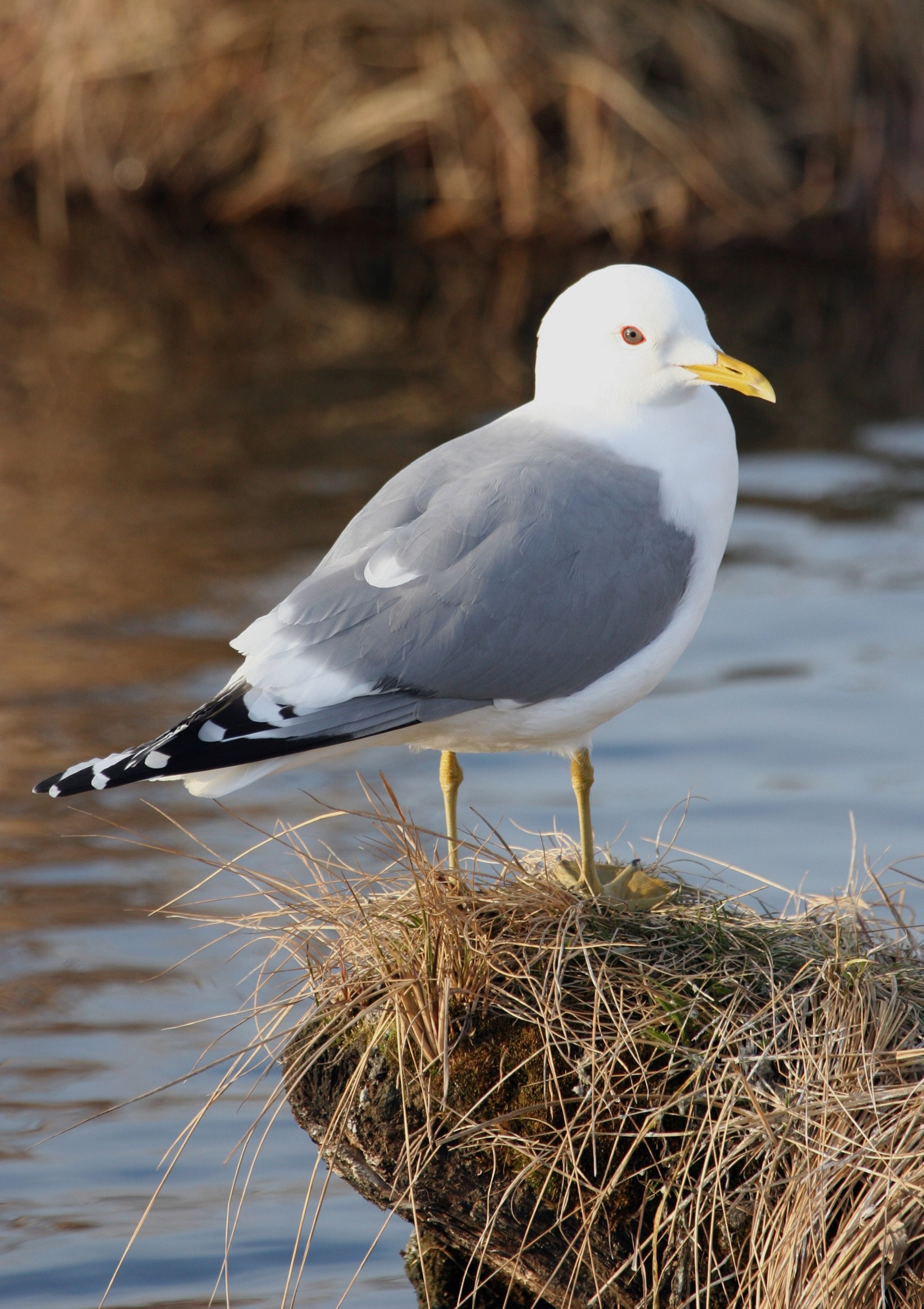

Order:
Charadriiformes
Charadriiformes (, from ''Charadrius'', the type genus of family Charadriidae) is a diverse order of small to medium-large birds. It includes about 390 species and has members in all parts of the world. Most charadriiform birds live near water an ...
Family:
Laridae
Laridae is a family of seabirds in the order Charadriiformes that includes the gulls, terns, skimmers and kittiwakes. It includes around 100 species arranged into 22 genera. They are an adaptable group of mostly aerial birds found worldwide.
T ...
Laridae is a family of medium to large
seabird
Seabirds (also known as marine birds) are birds that are adapted to life within the marine environment. While seabirds vary greatly in lifestyle, behaviour and physiology, they often exhibit striking convergent evolution, as the same enviro ...
s, the gulls, terns, and Skimmer (bird), skimmers. Gulls are typically grey or white, often with black markings on the head or wings. They have stout, longish bills and webbed feet. Terns are a group of generally medium to large seabirds typically with grey or white plumage, often with black markings on the head. Most terns hunt fish by diving but some pick insects off the surface of fresh water. Terns are generally long-lived birds, with several species known to live in excess of 30 years. Skimmers are a small family of tropical tern-like birds. They have an elongated lower mandible which they use to feed by flying low over the water surface and skimming the water for small fish.


Skuas

Order:
Charadriiformes
Charadriiformes (, from ''Charadrius'', the type genus of family Charadriidae) is a diverse order of small to medium-large birds. It includes about 390 species and has members in all parts of the world. Most charadriiform birds live near water an ...
Family: Stercorariidae
The family Stercorariidae are, in general, medium to large birds, typically with grey or brown plumage, often with white markings on the wings. They nest on the ground in temperate and arctic regions and are long-distance migrants. There are five species which have been recorded in India.
Tropicbirds

Order: PhaethontiformesFamily: Phaethontidae
Tropicbirds are slender white birds of tropical oceans, with exceptionally long central tail feathers. Their heads and long wings have black markings.
Loons
Order: GaviiformesFamily: Gaviidae
Loons, known as "divers" in Europe, are a group of aquatic birds found in northern North America and northern Eurasia. They are the size of a large duck or small goose, which they somewhat resemble when swimming, but to which they are completely unrelated. There are two species which have been recorded in India.
Austral storm petrels

Order: ProcellariiformesFamily: Oceanitidae
The storm petrels are relatives of the petrels and are the smallest seabirds. They feed on planktonic crustaceans and small fish picked from the surface, typically while hovering. The flight is fluttering and sometimes bat-like.
Northern storm petrels
Order: ProcellariiformesFamily: Hydrobatidae
The northern storm petrels are relatives of the petrels and are the smallest seabirds. They feed on planktonic crustaceans and small fish picked from the surface, typically while hovering. The flight is fluttering and sometimes bat-like.
Petrels, shearwaters, and diving petrels
Order: ProcellariiformesFamily: Procellariidae
The procellariids are the main group of medium-sized "true petrels", characterised by united nostrils with medium septum and a long outer functional primary. There are 9 species which have been recorded in India.
Storks
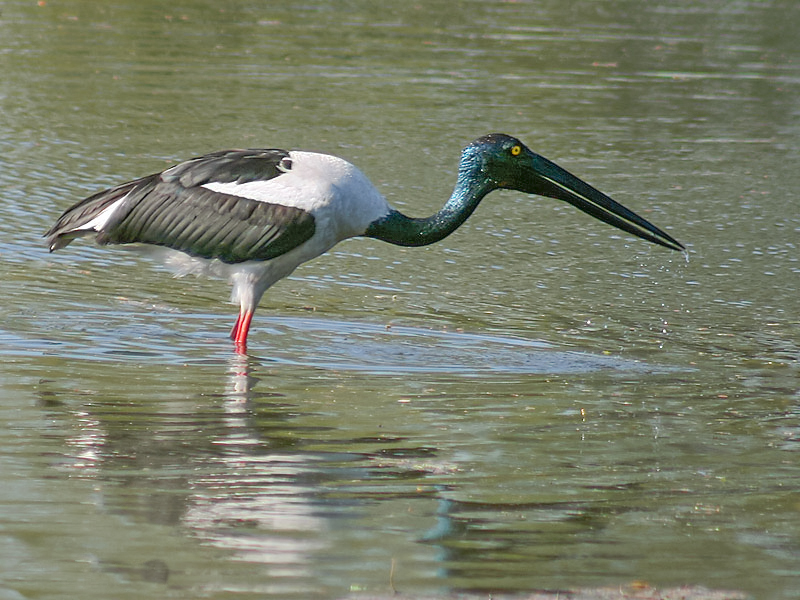
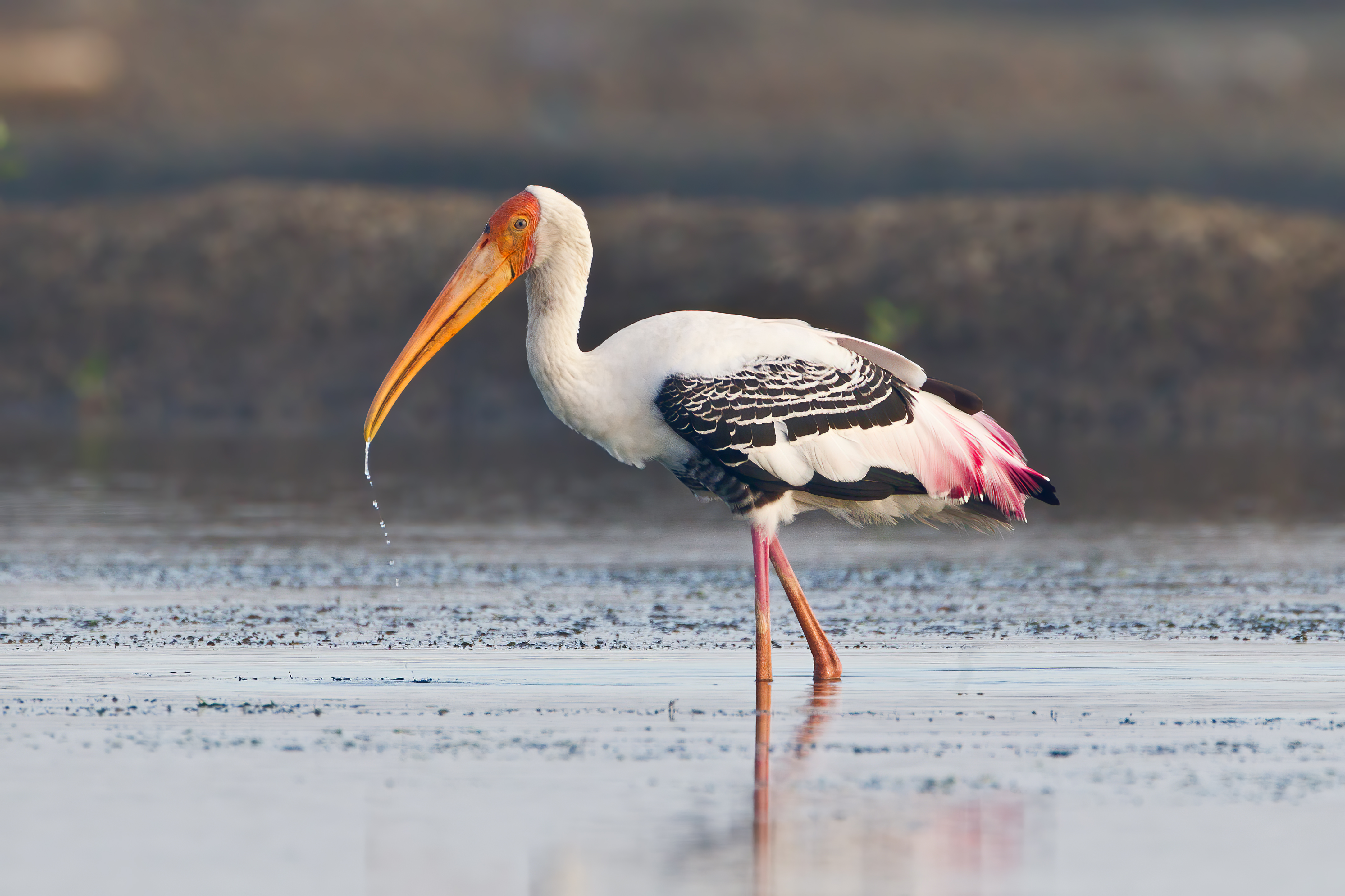
Order: CiconiiformesFamily: Ciconiidae
Storks are large, long-legged, long-necked, wading birds with long, stout bills. Storks are mute, but bill-clattering is an important mode of communication at the nest. Their nests can be large and may be reused for many years. Many species are migratory.
Frigatebirds

Order: SuliformesFamily: Fregatidae
Frigatebirds are large seabirds usually found over tropical oceans. They are large, black-and-white or completely black, with long wings and deeply forked tails. The males have coloured inflatable throat pouches. They do not swim or walk and cannot take off from a flat surface. Having the largest wingspan-to-body-weight ratio of any bird, they are essentially aerial, able to stay aloft for more than a week.
Gannets and boobies
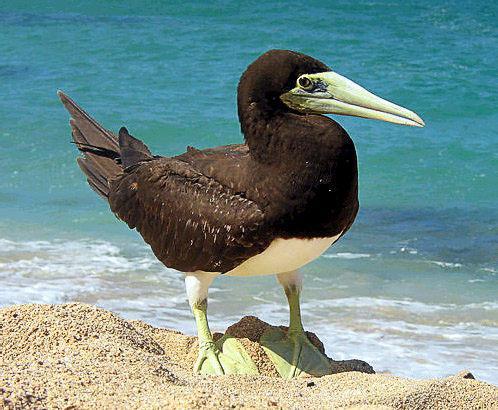
Order: SuliformesFamily: Sulidae
The sulids comprise the gannets and Booby, boobies. Both groups are medium to large coastal seabirds that plunge-dive for fish.
Anhingas and darters

Order: SuliformesFamily: Anhingidae
Darters are often called "snake-birds" because of their long thin neck, which gives a snake-like appearance when they swim with their bodies submerged. The males have black and dark-brown plumage, an erectile crest on the nape and a larger bill than the female. The females have much paler plumage especially on the neck and underparts. The darters have completely webbed feet and their legs are short and set far back on the body. Their plumage is somewhat permeable, like that of cormorants, and they spread their wings to dry after diving.
Cormorants and shags

Order: SuliformesFamily: Phalacrocoracidae
Phalacrocoracidae is a family of medium to large coastal, fish-eating seabirds that includes cormorants and shags. Plumage colouration varies, with the majority having mainly dark plumage, some species being black-and-white and a few being colourful.
Ibises and spoonbills


Order: PelecaniformesFamily: Threskiornithidae
Threskiornithidae is a family of large terrestrial and wading birds which includes the ibises and spoonbills. They have long, broad wings with 11 primary and about 20 secondary feathers. They are strong fliers and despite their size and weight, very capable soarers.
Herons and bitterns
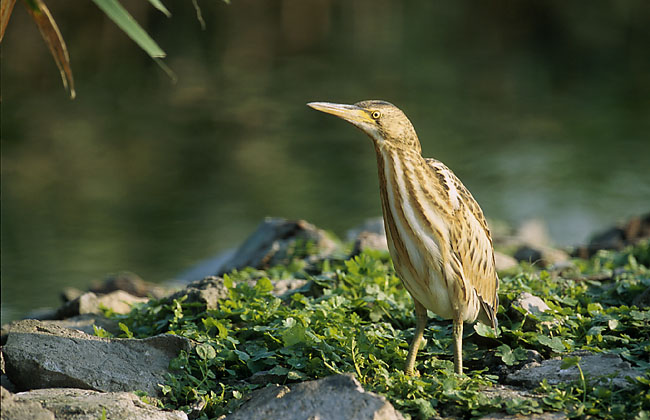
Order: PelecaniformesFamily: Ardeidae
The family Ardeidae contains the bitterns, herons and egrets. Herons and egrets are medium to large wading birds with long necks and legs. Bitterns tend to be shorter necked and more wary. Members of Ardeidae fly with their necks retracted, unlike other long-necked birds such as storks, ibises and spoonbills.
Pelicans

Order: PelecaniformesFamily: Pelecanidae
Pelicans are large water birds with a distinctive pouch under their beak. As with other members of the order Pelecaniformes, they have webbed feet with four toes. There are three species which have been recorded in India.
Osprey

Order: AccipitriformesFamily: Pandionidae
The family Pandionidae contains usually only one species, the osprey. The osprey is a medium-large bird of prey, raptor which is a specialist fish-eater with most taxonomic authorities consider a worldwide distribution.
Kites, hawks, and eagles


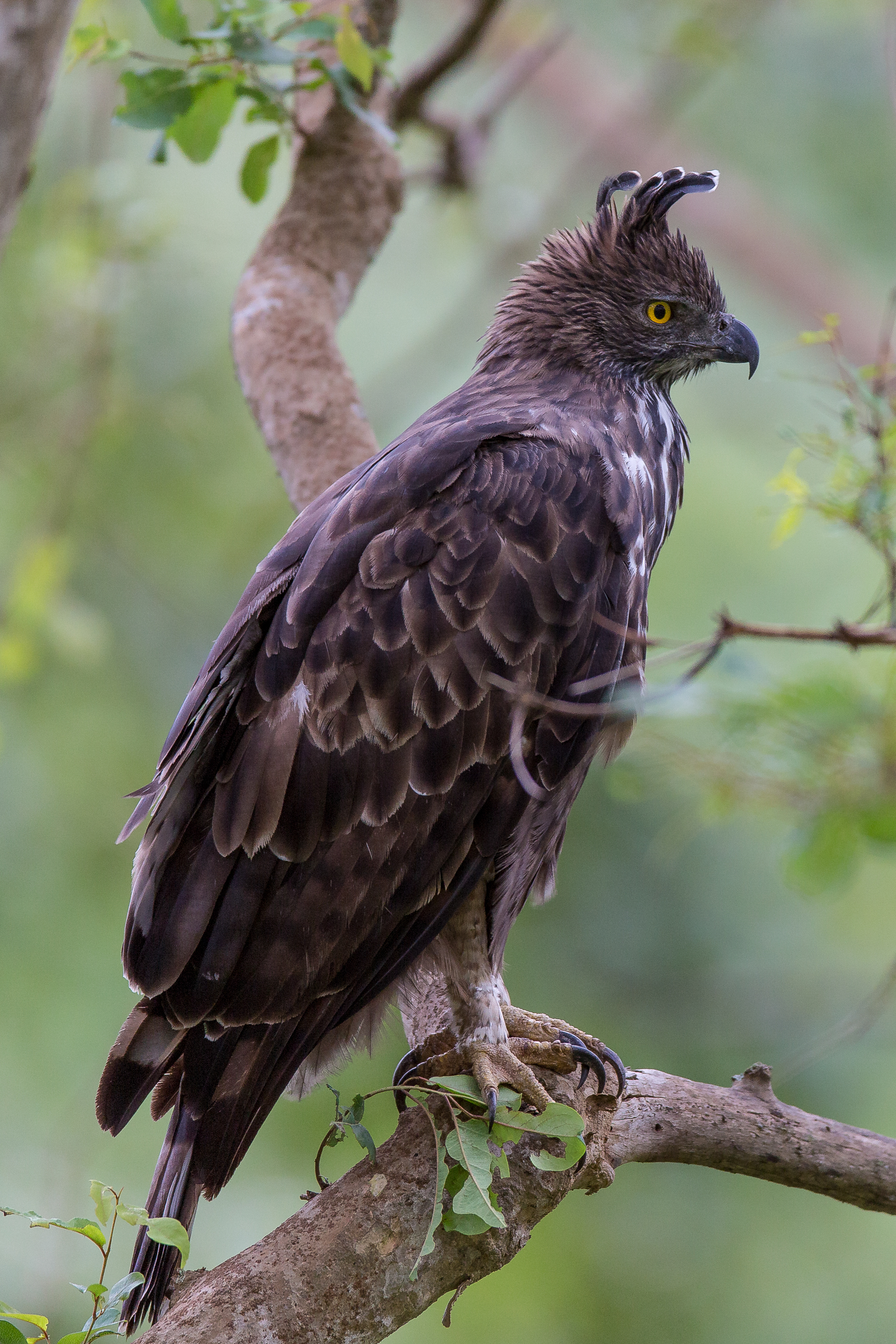


Order: AccipitriformesFamily: Accipitridae
Accipitridae is a family of birds of prey, which includes hawks, eagles, Kite (bird), kites, Harrier (bird), harriers and Old World vultures. These birds have powerful hooked beaks for tearing flesh from their prey, strong legs, powerful talons and keen eyesight.
Barn owls
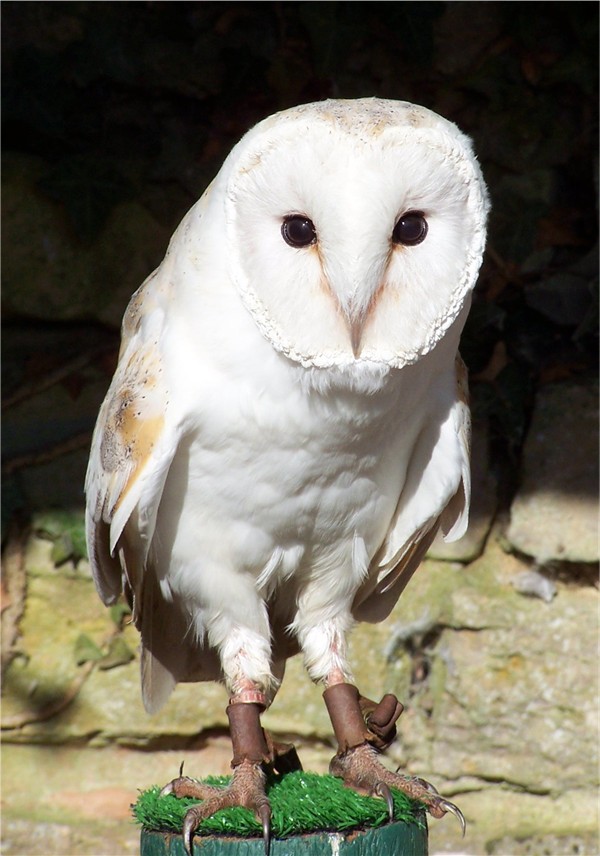
Order: StrigiformesFamily: Tytonidae
Barn owls are medium to large owls with large heads and characteristic heart-shaped faces. They have long strong legs with powerful talons.
Owls
Order: StrigiformesFamily: Strigidae
The typical owls are small to large solitary nocturnal birds of prey. They have large forward-facing eyes and ears, a hawk-like beak and a conspicuous circle of feathers around each eye called a facial disk.
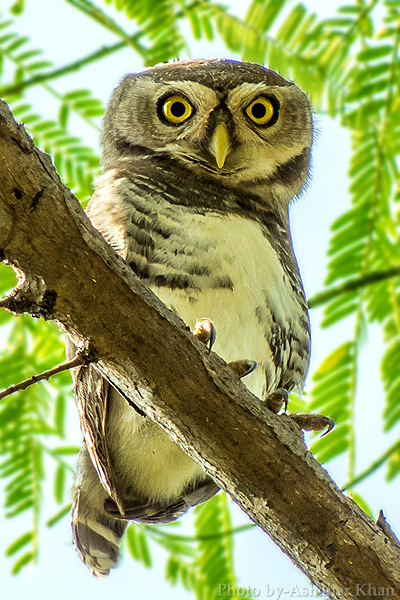
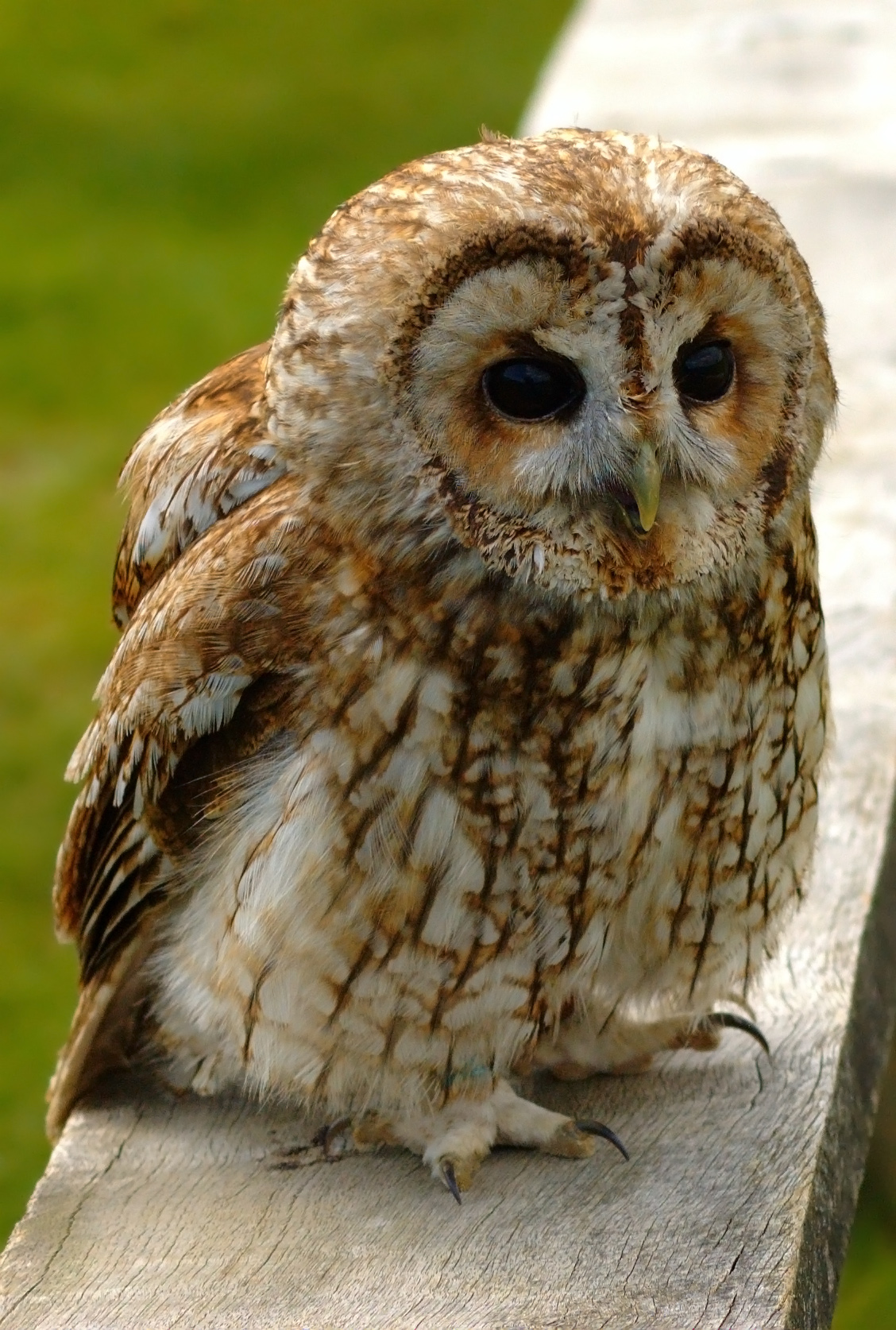
Trogons

Order: TrogoniformesFamily: Trogonidae
The family Trogonidae includes trogons and quetzals. Found in tropical woodlands worldwide, they feed on insects and fruit, and their broad bills and weak legs reflect their diet and arboreal habits. Although their flight is fast, they are reluctant to fly any distance. Trogons have soft, often colourful, feathers with distinctive male and female plumage. There are three species which have been recorded in India.
Hoopoes
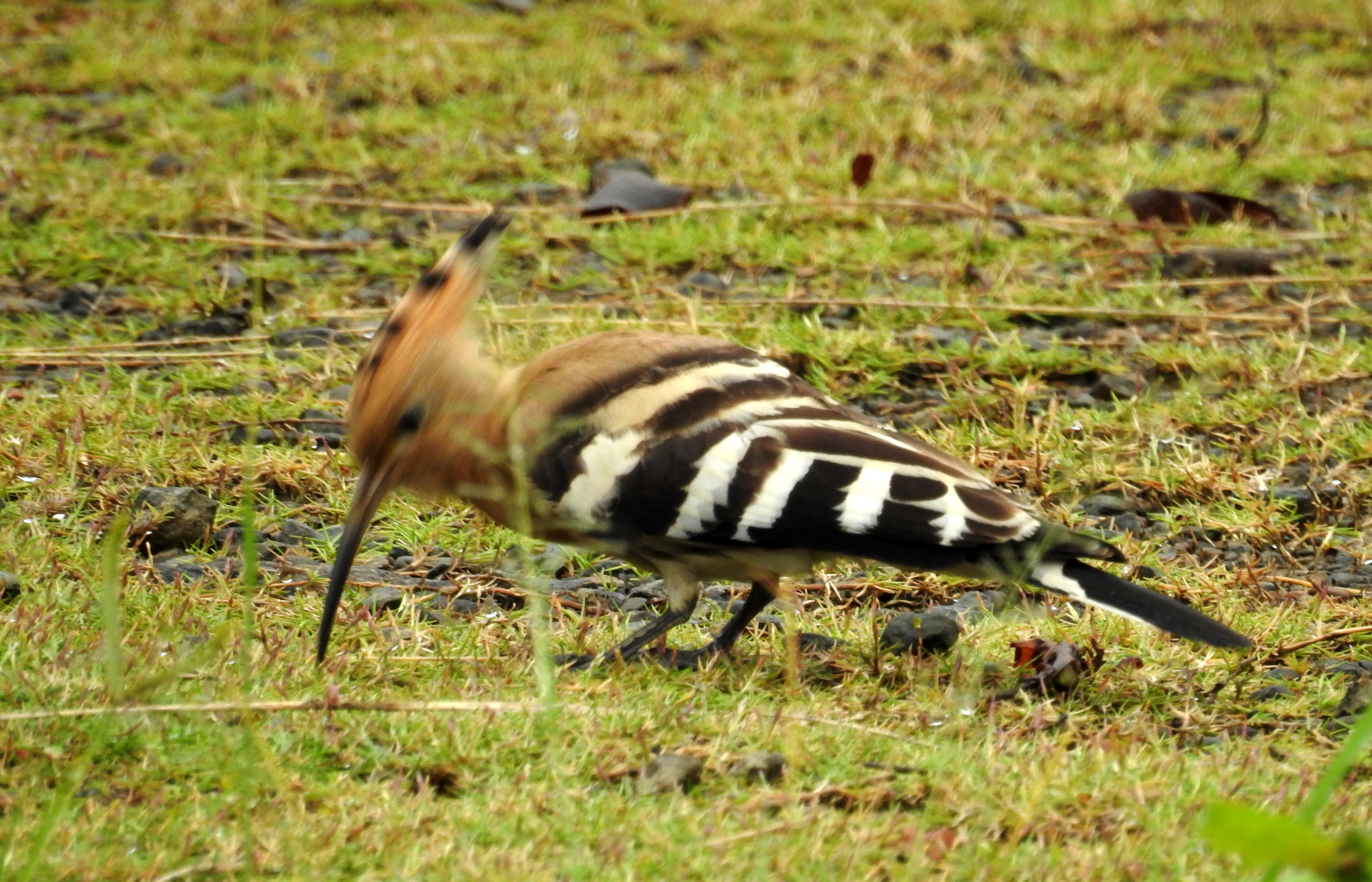
Order: BucerotiformesFamily: Upupidae
Hoopoes have black, white and orangey-pink colouring with a large erectile crest on their head. There is one species which occurs in India.
Hornbills


Order: BucerotiformesFamily: Bucerotidae
Hornbills are a group of birds whose bill is shaped like a cow's horn, but without a twist, sometimes with a casque on the upper mandible. Frequently, the bill is brightly coloured.

Rollers
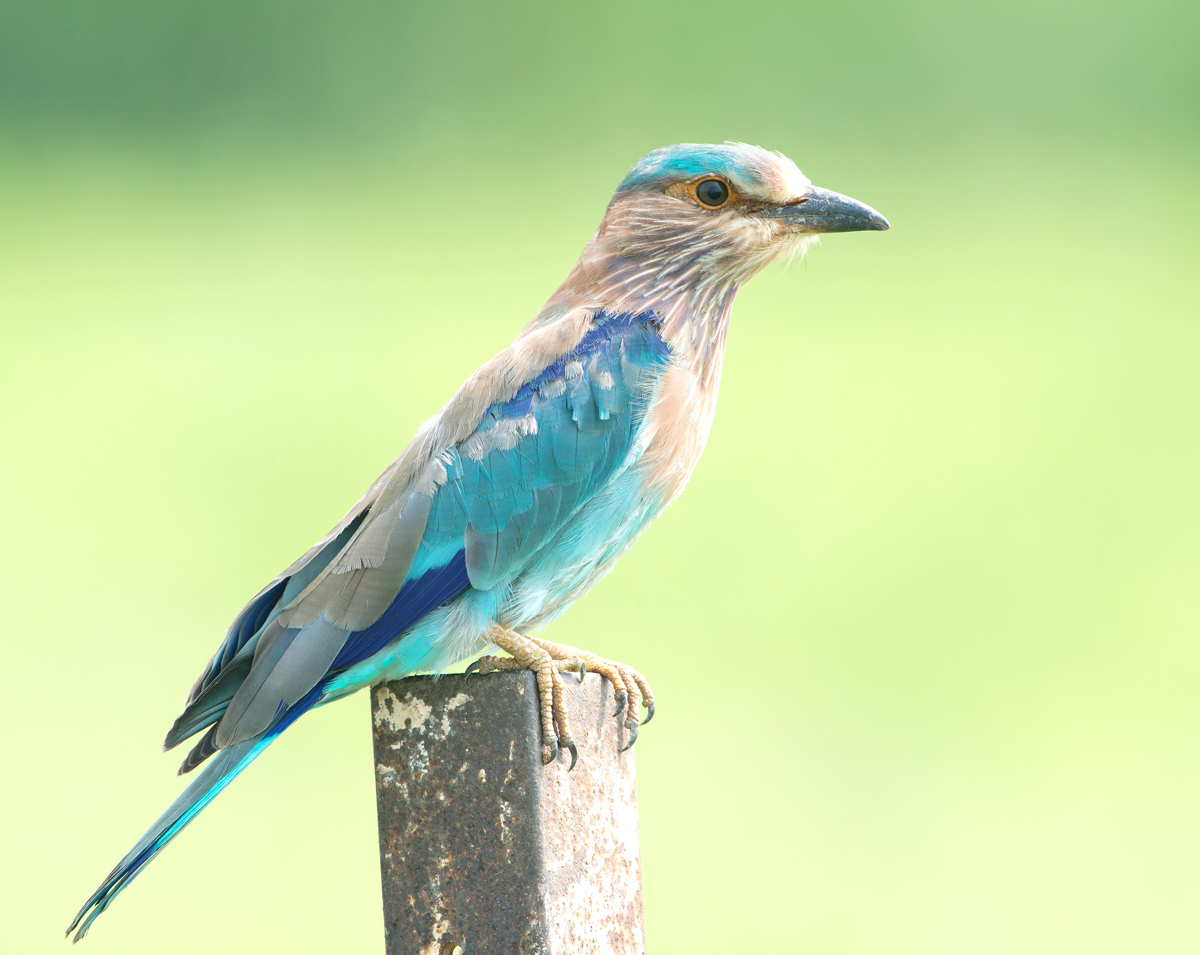
Order: CoraciiformesFamily: Coraciidae
Rollers resemble crows in size and build, but are more closely related to the kingfishers and bee-eaters. They share the colourful appearance of those groups with blues and browns predominating. The two inner front toes are connected at the base, but the outer toe is not. There are three or four species (depending on taxonomy followed) which have been recorded in India.
Kingfishers

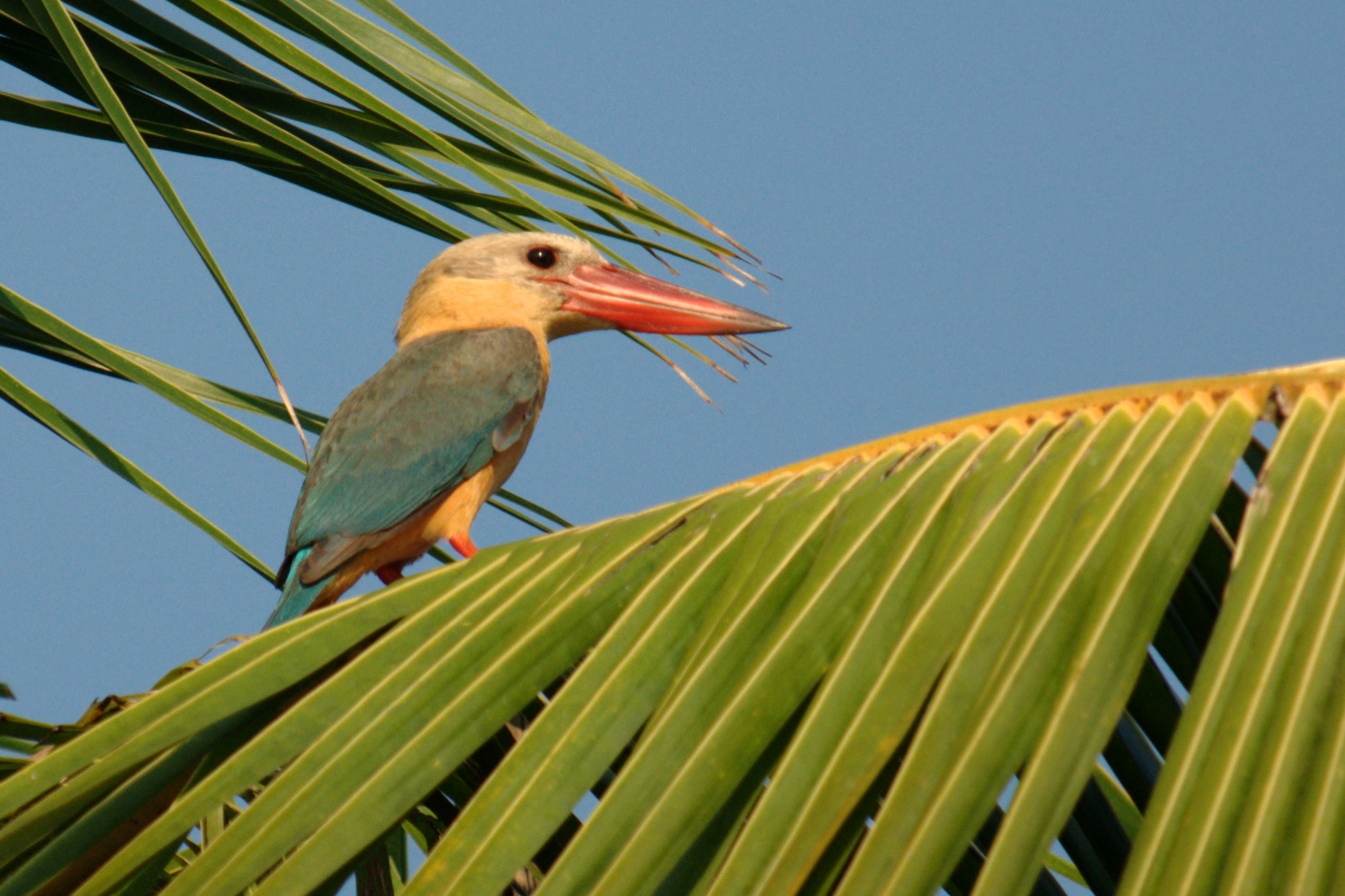
Order: CoraciiformesFamily: Alcedinidae
Kingfishers are medium-sized birds with large heads, long, pointed bills, short legs and stubby tails. There are 13 species which have been recorded in India.
Bee-eaters

Order: CoraciiformesFamily: Meropidae
The bee-eaters are a group of near passerine birds in the family Meropidae. Most species are found in Africa but others occur in southern Europe, Madagascar, Australia and New Guinea. They are characterised by richly coloured plumage, slender bodies and usually elongated central tail feathers. All are colourful and have long downturned bills and pointed wings, which give them a swallow-like appearance when seen from afar. There are 7 species which have been recorded in India.
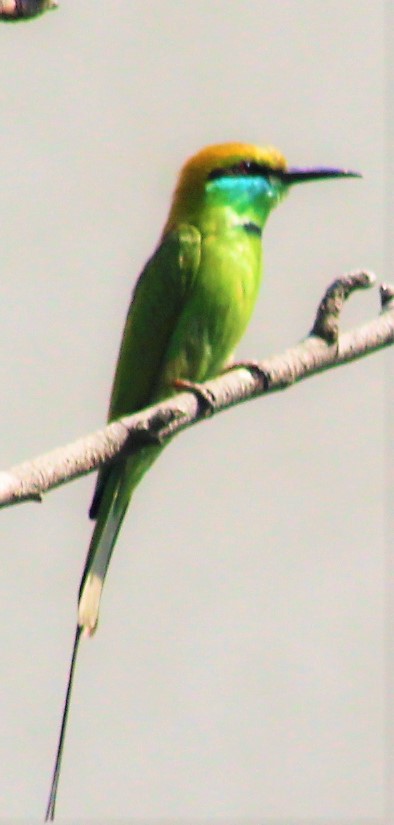
Asian barbets

Order: PiciformesFamily: Megalaimidae
The Asian barbets are plump birds, with short necks and large heads. They get their name from the bristles which fringe their heavy bills. Most species are brightly coloured.
Honeyguides
Order: PiciformesFamily: Indicatoridae
Honeyguides are among the few birds that feed on wax. They are named for the greater honeyguide which leads traditional honey-hunters to bees' nests and, after the hunters have harvested the honey, feeds on the remaining contents of the hive. There is one species which occurs in India.
Woodpeckers

Order: PiciformesFamily: Picidae
Woodpeckers are small to medium-sized birds with chisel-like beaks, short legs, stiff tails and long tongues used for capturing insects. Some species have feet with two toes pointing forward and two backward, while several species have only three toes. Many woodpeckers have the habit of tapping noisily on tree trunks with their beaks.


Caracaras and falcons
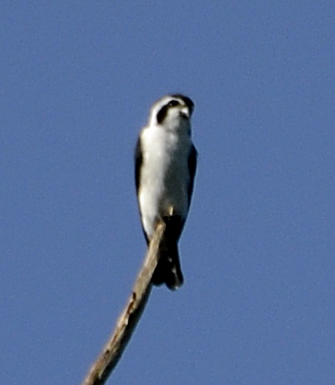

Order: FalconiformesFamily: Falconidae
Falconidae is a family of diurnal birds of prey. They differ from hawks, eagles and kites in that they kill with their beaks instead of their talons. There are thirteen species which have been recorded in India.
Old World parrots
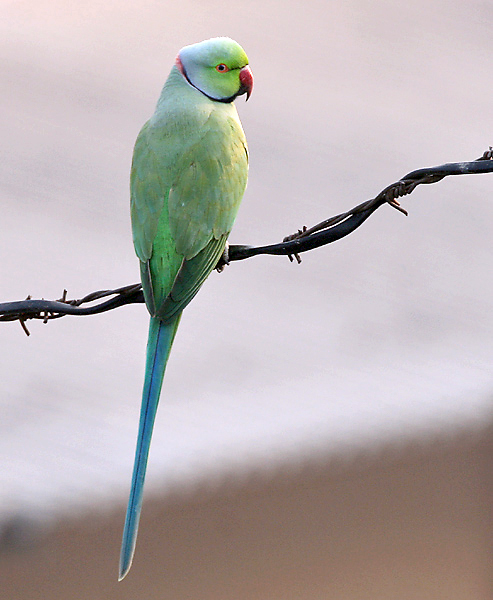
Order: PsittaciformesFamily: Psittaculidae
Characteristic features of parrots include a strong curved bill, an upright stance, strong legs, and clawed zygodactyl feet. Many parrots are vividly coloured, and some are multi-coloured. In size they range from to in length. Old World parrots are found from Africa east across south and southeast Asia and Oceania to Australia and New Zealand.
Typical broadbills

Order: PasseriformesFamily: Eurylaimidae
The broadbills are small, brightly coloured birds, which feed on fruit and also take insects in flycatcher fashion, snapping their broad bills. Their habitat is canopies of wet forests. There are two species which have been recorded in India.
Pittas

Order: PasseriformesFamily: Pittidae
Pittas are medium-sized by passerine standards and are stocky, with fairly long, strong legs, short tails and stout bills. Many are brightly coloured. They spend the majority of their time on wet forest floors, eating snails, insects and similar invertebrates.
Vangas, helmetshrikes, woodshrikes, and shrike-flycatchers

Order: PasseriformesFamily: Vangidae
The woodshrikes are similar in build to the shrikes.
Woodswallows, butcherbirds, and peltops

Order: PasseriformesFamily: Artamidae
The woodswallows are soft-plumaged, somber-coloured passerine birds. They are smooth, agile flyers with moderately large, semi-triangular wings. There are two species which have been recorded in India.
Ioras
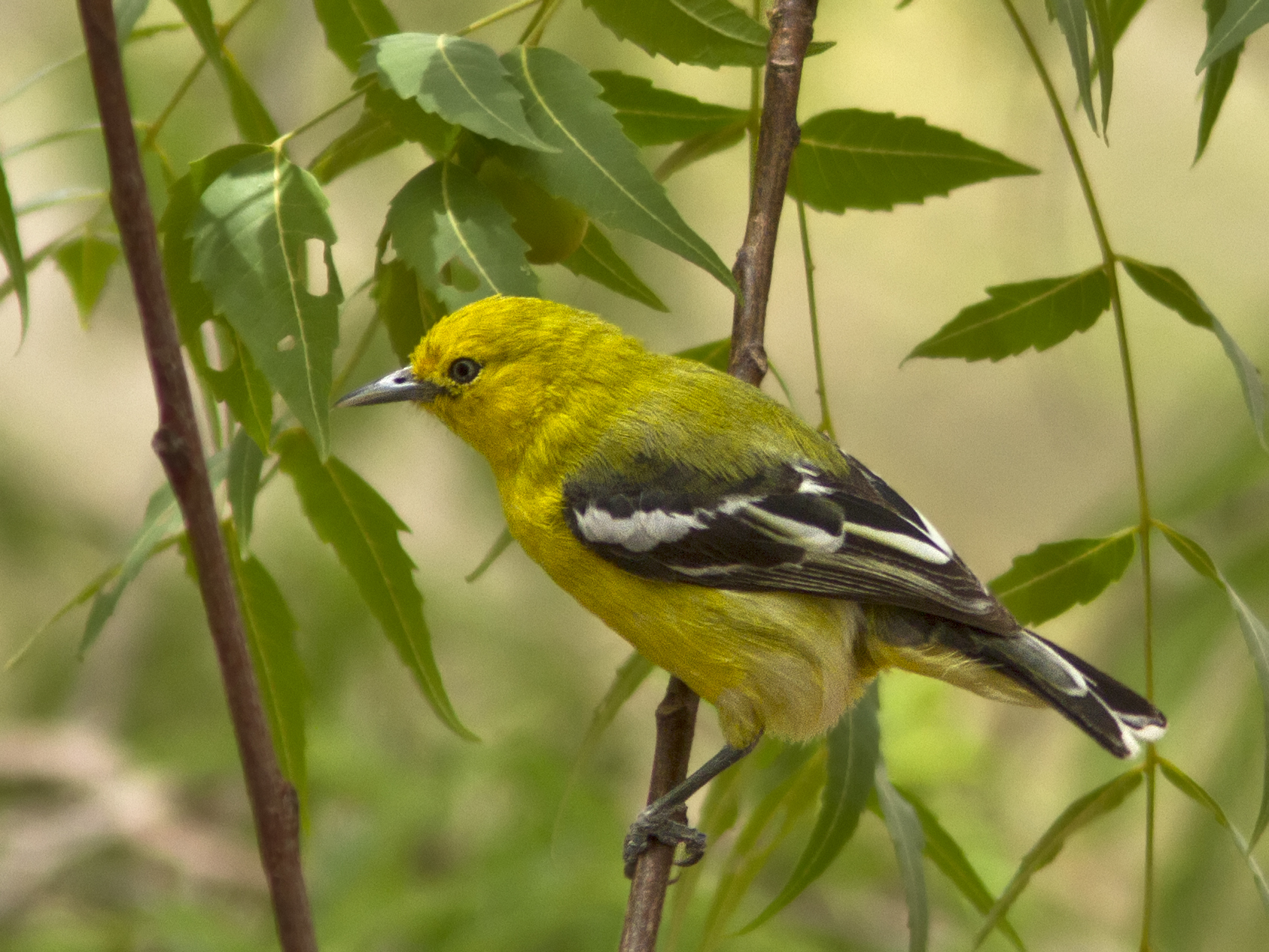
Order: PasseriformesFamily: Aegithinidae
The ioras are bulbul-like birds of open forest or thorn scrub, but whereas that group tends to be drab in colouration, ioras are sexually dimorphic, with the males being brightly plumaged in yellows and greens. There are two species which have been recorded in India.

Cuckooshrikes

Order: PasseriformesFamily: Campephagidae
The cuckooshrikes are small to medium-sized passerine birds. They are predominantly greyish with white and black, although some species are brightly coloured. There are 14 species which have been recorded in India.
Whistlers and allies
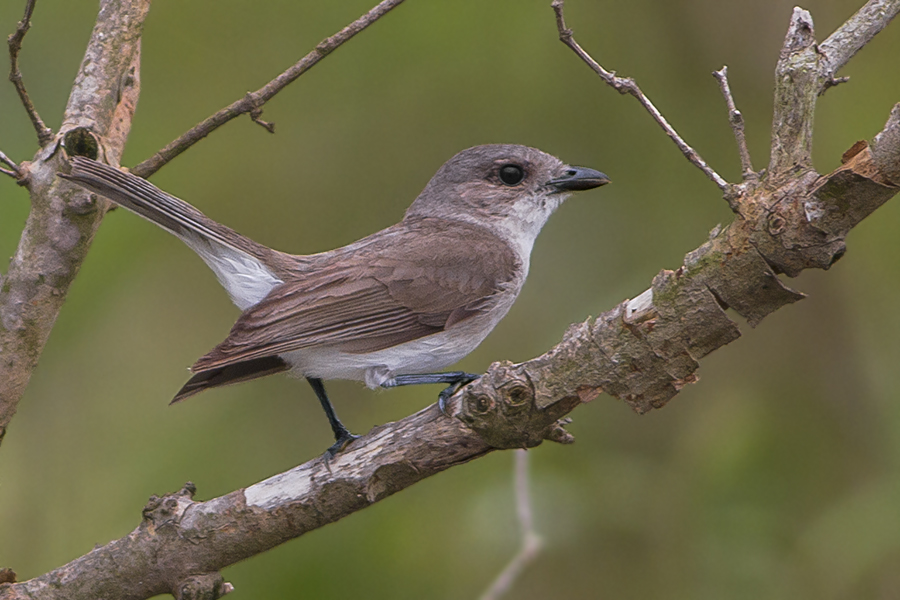
Order: PasseriformesFamily: Pachycephalidae
The family Pachycephalidae includes the whistlers, shrikethrushes, and some of the pitohuis. There is one species which occurs in India.
Shrikes

Order: PasseriformesFamily: Laniidae
Shrikes are passerine birds known for their habit of catching other birds and small animals and impaling the uneaten portions of their bodies on thorns. A typical shrike's beak is hooked, like a bird of prey.

Vireos, greenlets, and shrike-babblers

Order: PasseriformesFamily: Vireonidae
Most of the members of this family are found in the New World. However, the shrike-babblers and erpornis, which only slightly resemble the "true" vireos and greenlets, are found in South East Asia.
Figbirds, orioles, and turnagra

Order: PasseriformesFamily: Oriolidae
The Old World orioles are colourful passerine birds. They are not related to the New World orioles. There are six species which have been recorded in India.
Drongos

Order: PasseriformesFamily: Dicruridae
The drongos are mostly black or dark grey in colour, sometimes with metallic tints. They have long forked tails, and some Asian species have elaborate tail decorations. They have short legs and sit very upright when perched, like a shrike. They flycatch or take prey from the ground. There are ten species which have been recorded in India.
Fantails and silktails

Order: PasseriformesFamily: Rhipiduridae
The fantails are small insectivorous birds which are specialist aerial feeders. There are three species which occur in India.
Monarchs

Order: PasseriformesFamily: Monarchidae
The monarch flycatchers are small to medium-sized insectivorous passerines which hunt by flycatching. There are four species which have been recorded in India.
Crows and jays

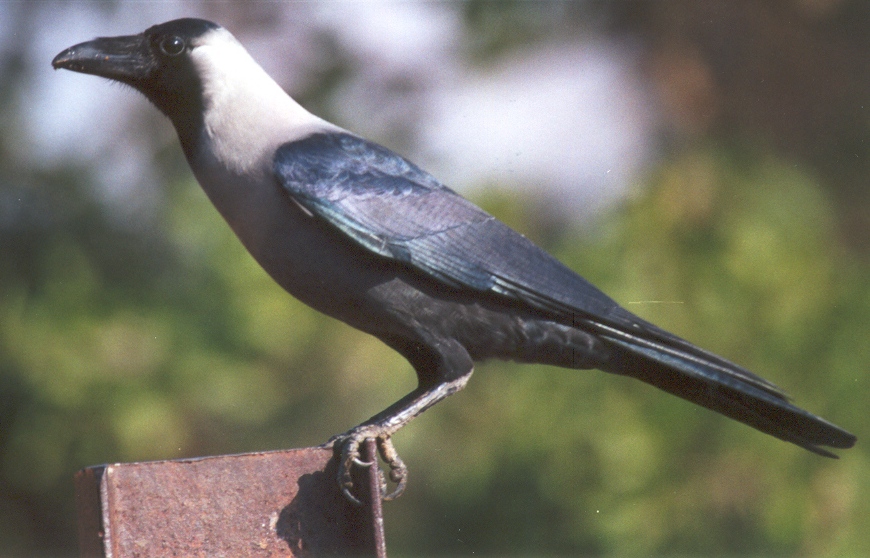
Order: PasseriformesFamily: Corvidae
The family Corvidae includes crows, ravens, jays, choughs, magpies, treepies, nutcracker (bird), nutcrackers and ground jays. Corvids are above average in size among the Passeriformes, and some of the larger species show high levels of intelligence.

Waxwings
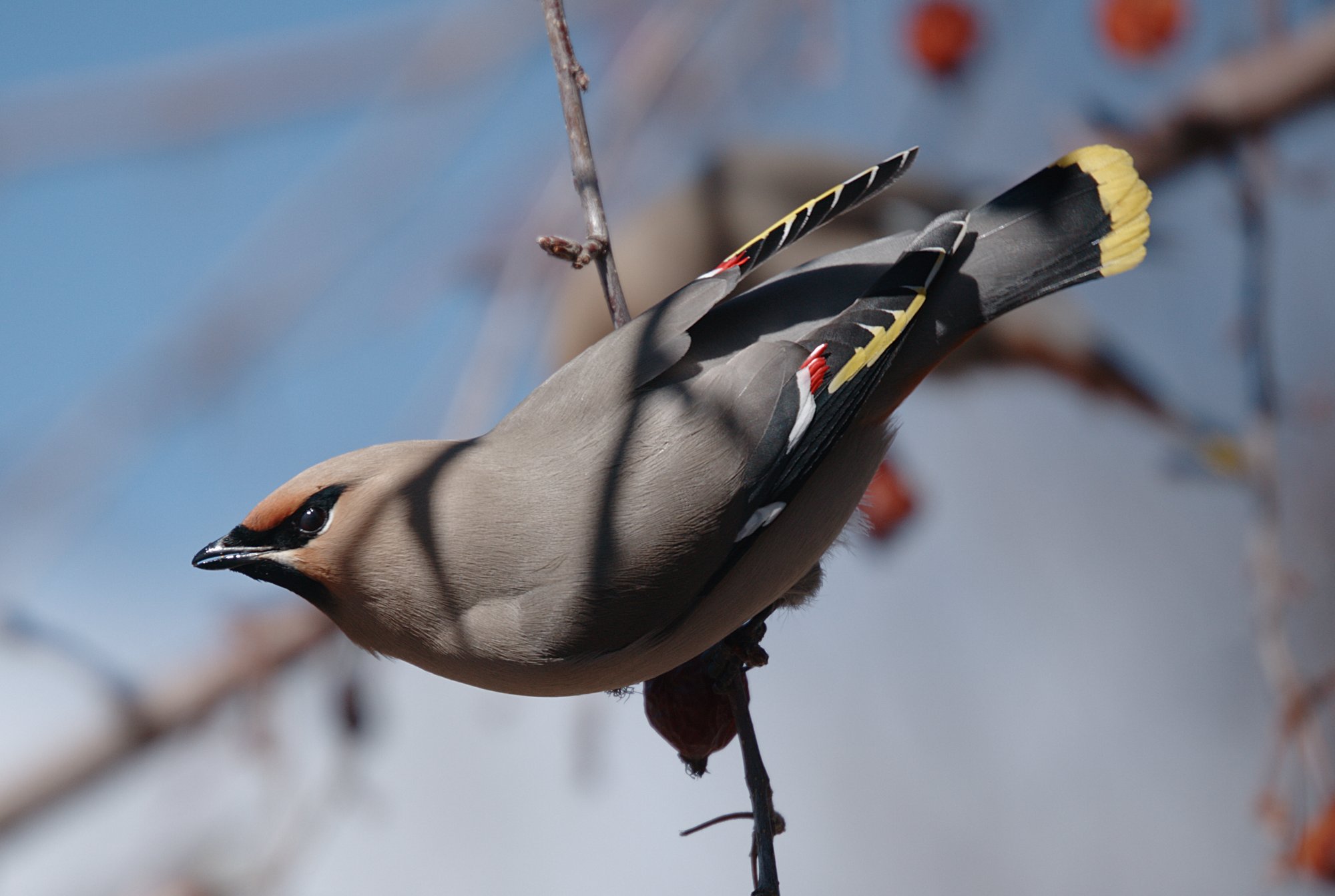
Order: PasseriformesFamily: Bombycillidae
The waxwings are a group of birds with soft silky plumage and unique red tips to some of the wing feathers. In the Bohemian and cedar waxwings, these tips look like sealing wax and give the group its name. These are arboreal birds of northern forests. They live on insects in summer and berries in winter. There is one species which occurs in India.
Hypocolius

Order: PasseriformesFamily: Hypocoliidae
The grey hypocolius is a small Middle Eastern bird with the shape and soft plumage of a waxwing. They are mainly a uniform grey colour except the males have a black triangular mask around their eyes.
Fairy flycatchers

Order: PasseriformesFamily: Stenostiridae
Most of the species of this small family are found in Africa, though a few inhabit tropical Asia. They are not closely related to other birds called "flycatchers".
Tits and chickadees

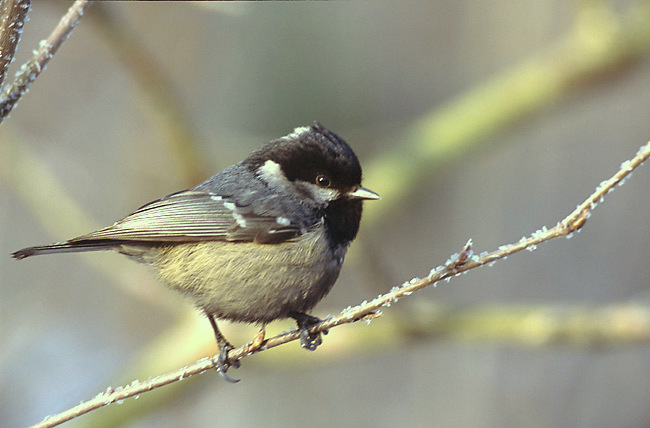
Order: PasseriformesFamily: Paridae
The Paridae are mainly small stocky woodland species with short stout bills. Some have crests. They are adaptable birds, with a mixed diet including seeds and insects.
Penduline tits
Order: PasseriformesFamily: Remizidae
The penduline tits are a group of small passerine birds related to the true tits. They are insectivores. There is one species which has been recorded in India.
Larks

Order: PasseriformesFamily: Alaudidae

Larks are small terrestrial birds with often extravagant songs and display flights. Most larks are fairly dull in appearance. Their food is insects and seeds.

Bulbuls


Order: PasseriformesFamily: Pycnonotidae

Bulbuls are medium-sized songbirds. Some are colourful with yellow, red or orange vents, cheeks, throats or supercilia, but most are drab, with uniform olive-brown to black plumage. Some species have distinct crests.

Swallows and martins

Order: PasseriformesFamily: Hirundinidae
The family Hirundinidae is adapted to aerial feeding. They have a slender streamlined body, long pointed wings and a short bill with a wide gape. The feet are adapted to perching rather than walking, and the front toes are partially joined at the base.

Cupwings
Order: PasseriformesFamily: Pnoepygidae
The members of this small family are found in mountainous parts of South and South East Asia.
Cettia bush warblers and allies
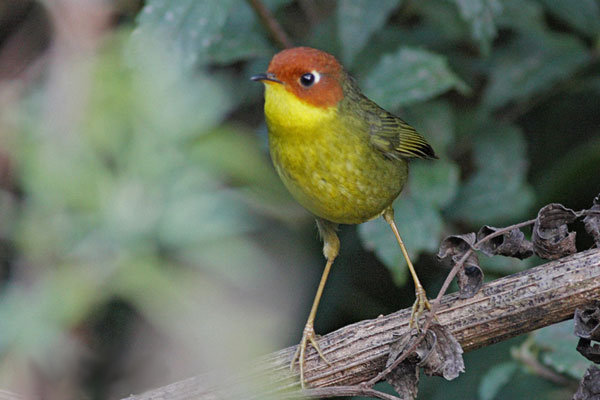
Order: PasseriformesFamily: Cettiidae
Cettiidae is a family of small insectivorous songbirds. It contains the typical bush warblers (Cettia) and their relatives. Its members occur mainly in Asia and Africa, ranging into Oceania and Europe.
Bushtits

Order: PasseriformesFamily: Aegithalidae
Long-tailed tits are a group of small passerine birds with medium to long tails. They make woven bag nests in trees. Most eat a mixed diet which includes insects.
Leaf warblers and allies
Order: PasseriformesFamily: Phylloscopidae

Leaf warblers are a family of small insectivorous birds found mostly in Eurasia and ranging into Wallacea and Africa. The species are of various sizes, often green-plumaged above and yellow below, or more subdued with grayish-green to grayish-brown colors.
Reed warblers, Grauer’s warbler, and allies
Order: PasseriformesFamily: Acrocephalidae
The members of this family are usually rather large for "warblers". Most are rather plain olivaceous brown above with much yellow to beige below. They are usually found in open woodland, reedbeds, or tall grass. The family occurs mostly in southern to western Eurasia and surroundings, but it also ranges far into the Pacific, with some species in Africa.
Grassbirds and allies

Order: PasseriformesFamily: Locustellidae

Locustellidae are a family of small insectivorous songbirds found mainly in Eurasia, Africa, and the Australian region. They are smallish birds with tails that are usually long and pointed, and tend to be drab brownish or buffy all over.
Cisticolas and allies

Order: PasseriformesFamily: Cisticolidae
The Cisticolidae are warblers found mainly in warmer southern regions of the Old World. They are generally very small birds of drab brown or grey appearance found in open country such as grassland or scrub.

Sylviid babblers

Order: PasseriformesFamily: Sylviidae
The family Sylviidae is a group of small insectivorous passerine birds. They mainly occur as breeding species, as the common name implies, in Europe, Asia and, to a lesser extent, Africa. Many species are difficult to identify by appearance, but many have distinctive songs.
Parrotbills and allies

Order: PasseriformesFamily: Paradoxornithidae
The parrotbills are a group of peculiar birds which are diverse along the Himalayas east into Southeast Asia, though feral populations exist elsewhere. They are generally small, long-tailed birds which inhabit reedbeds and similar habitat. They feed mainly on seeds, e.g. of grasses, to which their bill, as the name implies, is well-adapted.
White-eyes
Order: PasseriformesFamily: Zosteropidae
The white-eyes are small and mostly undistinguished, their plumage above being generally some dull colour like greenish-olive, but some species have a white or bright yellow throat, breast or lower parts, and several have buff flanks. As their name suggests, many species have a white ring around each eye.
Babblers and scimitar babblers
Order: PasseriformesFamily: Timaliidae

The babblers, or timaliids, are somewhat diverse in size and colouration, but are characterised by soft fluffy plumage.


Ground babblers
Order: PasseriformesFamily: Pellorneidae
These small to medium-sized songbirds have soft fluffy plumage but are otherwise rather diverse. Members of the genus ''Illadopsis'' are found in forests, but some other genera are birds of scrublands.
Alcippe fulvettas

Order: PasseriformesFamily: Alcippeidae
The genus once included many other fulvettas and was previously placed in families Pellorneidae or Timaliidae.
Laughingthrushes and allies
Order: PasseriformesFamily: Leiothrichidae
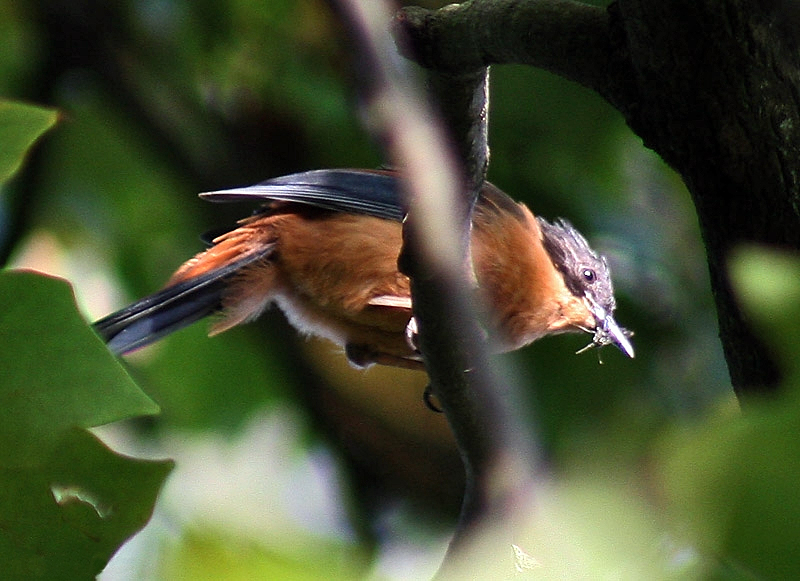


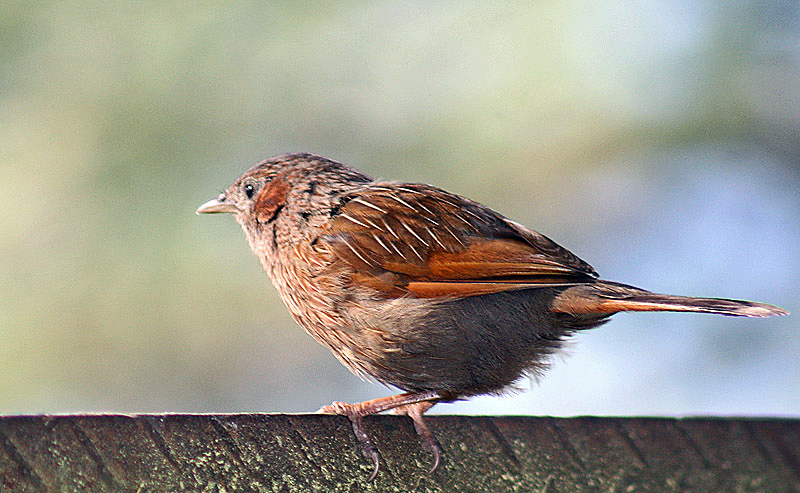
The members of this family are diverse in size and colouration, though those of genus ''Turdoides'' tend to be brown or greyish. The family is found in Africa, India, and southeast Asia.
Fairy-bluebirds
Order: PasseriformesFamily: Irenidae
The fairy-bluebirds are bulbul-like birds of open forest or thorn scrub. The males are dark-blue and the females a duller green. There is one species which occurs in India.
Goldcrests and kinglets
Order: PasseriformesFamily: Regulidae
The kinglets, also called crests, are a small group of birds often included in the Old World warblers, but frequently given family status because they also resemble the titmouse, titmice. There is one species which occurs in India.
Elachura
Order: PasseriformesFamily: Elachuridae
This species, the only one in its family, inhabits forest undergrowth throughout South East Asia.
Wrens
Order: PasseriformesFamily: Troglodytidae
The wrens are mainly small and inconspicuous except for their loud songs. These birds have short wings and thin down-turned bills. Several species often hold their tails upright. All are insectivorous. There is one species which occurs in India.
Nuthatches
Order: PasseriformesFamily: Sittidae
Nuthatches are small woodland birds. They have the unusual ability to climb down trees head first, unlike other birds which can only go upwards. Nuthatches have big heads, short tails and powerful bills and feet.
Wallcreeper
Order: PasseriformesFamily: Tichodromidae
The wallcreeper is a small bird related to the nuthatch family, which has stunning crimson, grey and black plumage.
Treecreepers
Order: PasseriformesFamily: Certhiidae
Treecreepers are small woodland birds, brown above and white below. They have thin pointed down-curved bills, which they use to extricate insects from bark. They have stiff tail feathers, like woodpeckers, which they use to support themselves on vertical trees.
Starlings and rhabdornis
Order: PasseriformesFamily: Sturnidae
Starlings are small to medium-sized passerine birds. Their flight is strong and direct and they are very gregarious. Their preferred habitat is fairly open country. They eat insects and fruit. Plumage is typically dark with a metallic sheen.

Thrushes



Order: PasseriformesFamily: Turdidae
The Thrush (bird), thrushes are a group of passerine birds that occur mainly in the Old World. They are plump, soft plumaged, small to medium-sized insectivores or sometimes omnivores, often feeding on the ground. Many have attractive songs.
Chats and Old World flycatchers


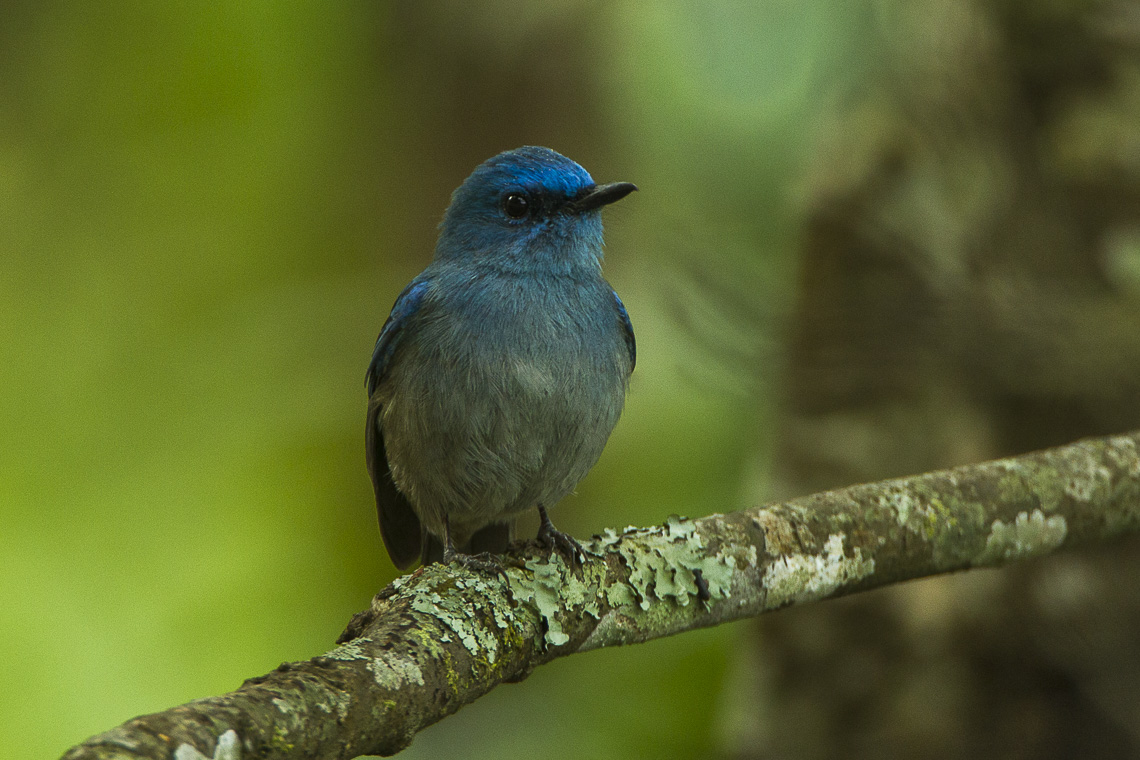
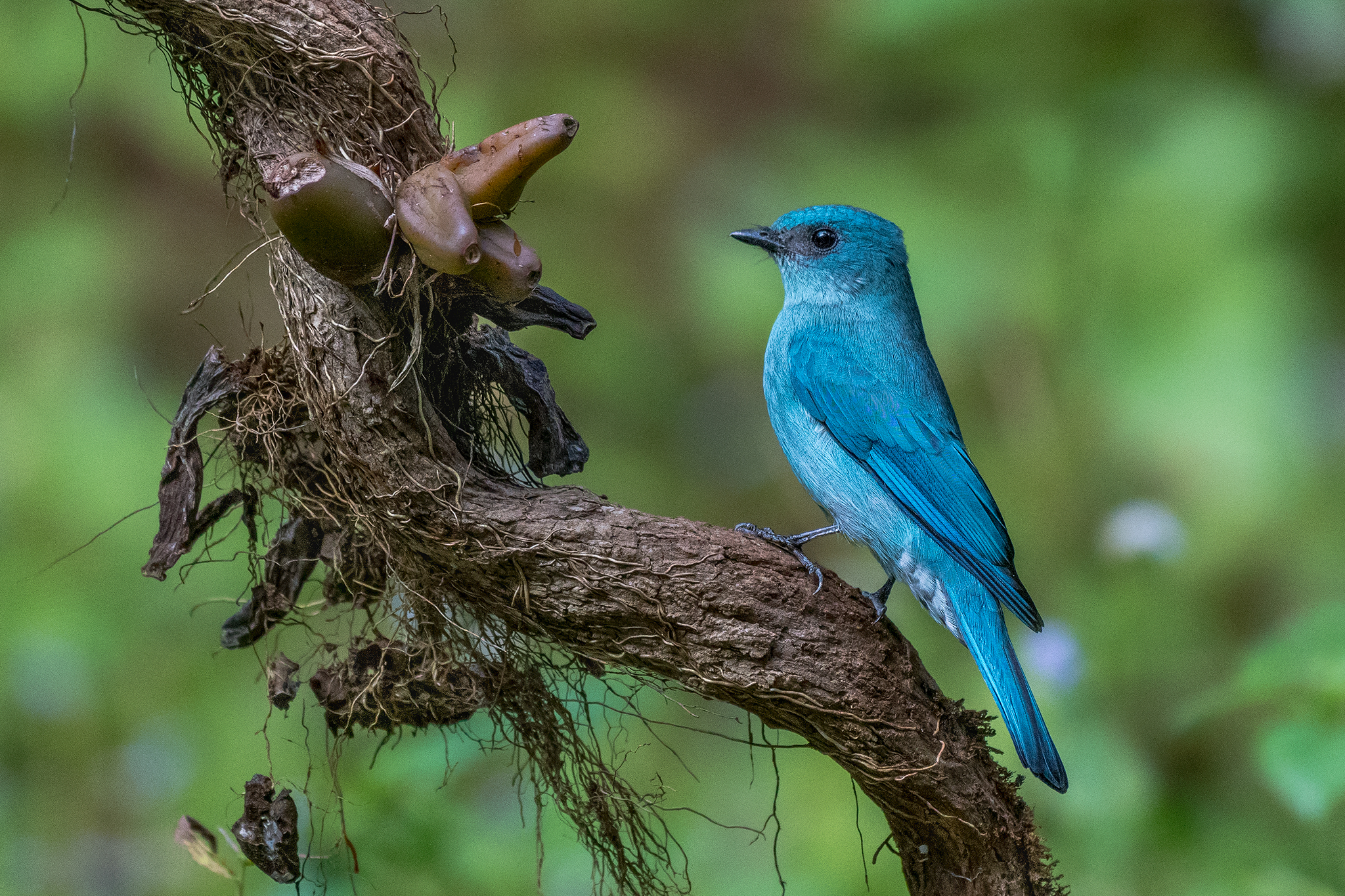

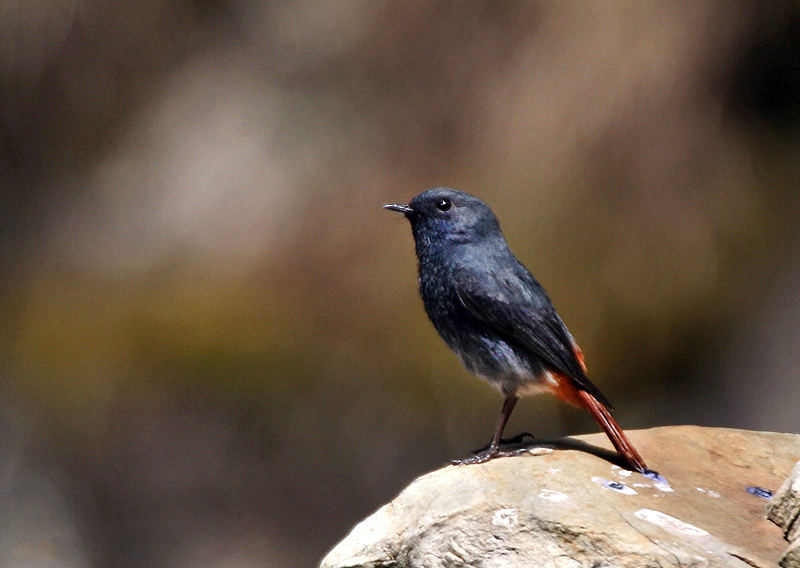


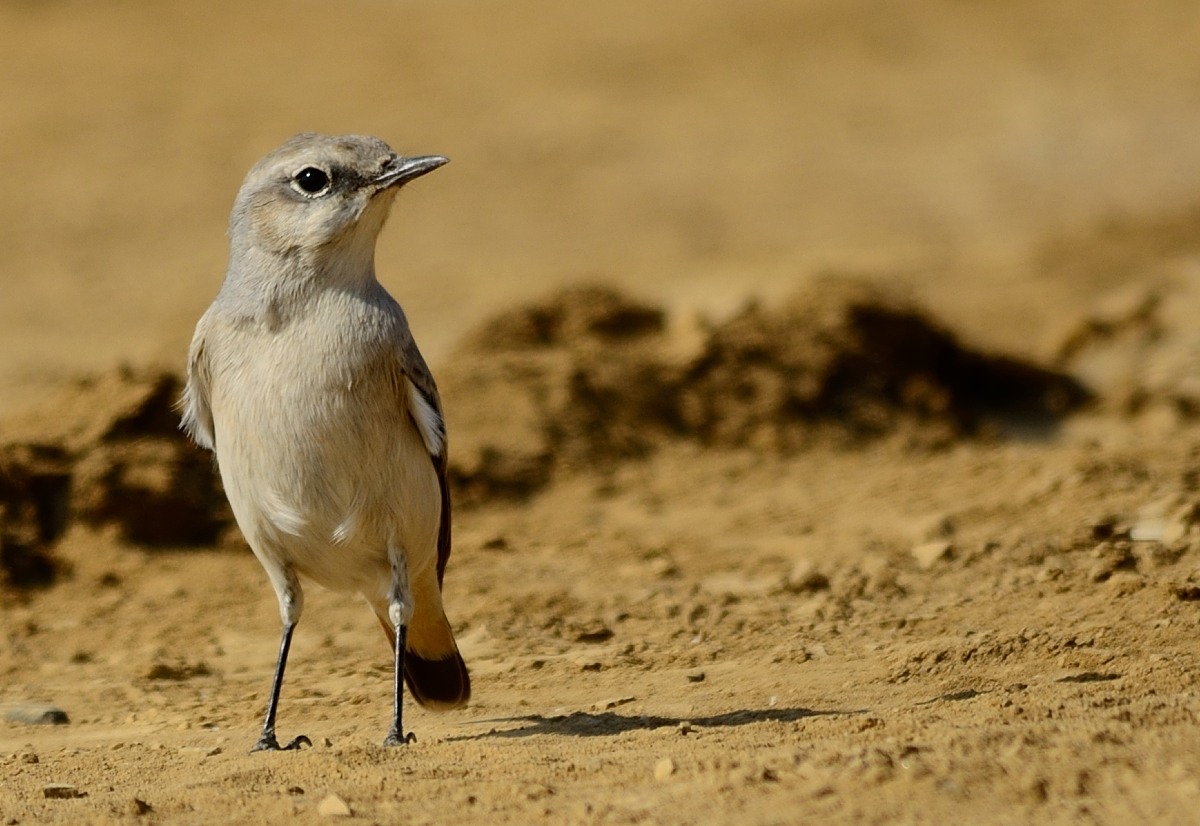
Order: PasseriformesFamily: Muscicapidae
Old World flycatchers are a large group of small passerine birds native to the Old World. They are mainly small arboreal insectivores. The appearance of these birds is highly varied, but they mostly have weak songs and harsh calls.
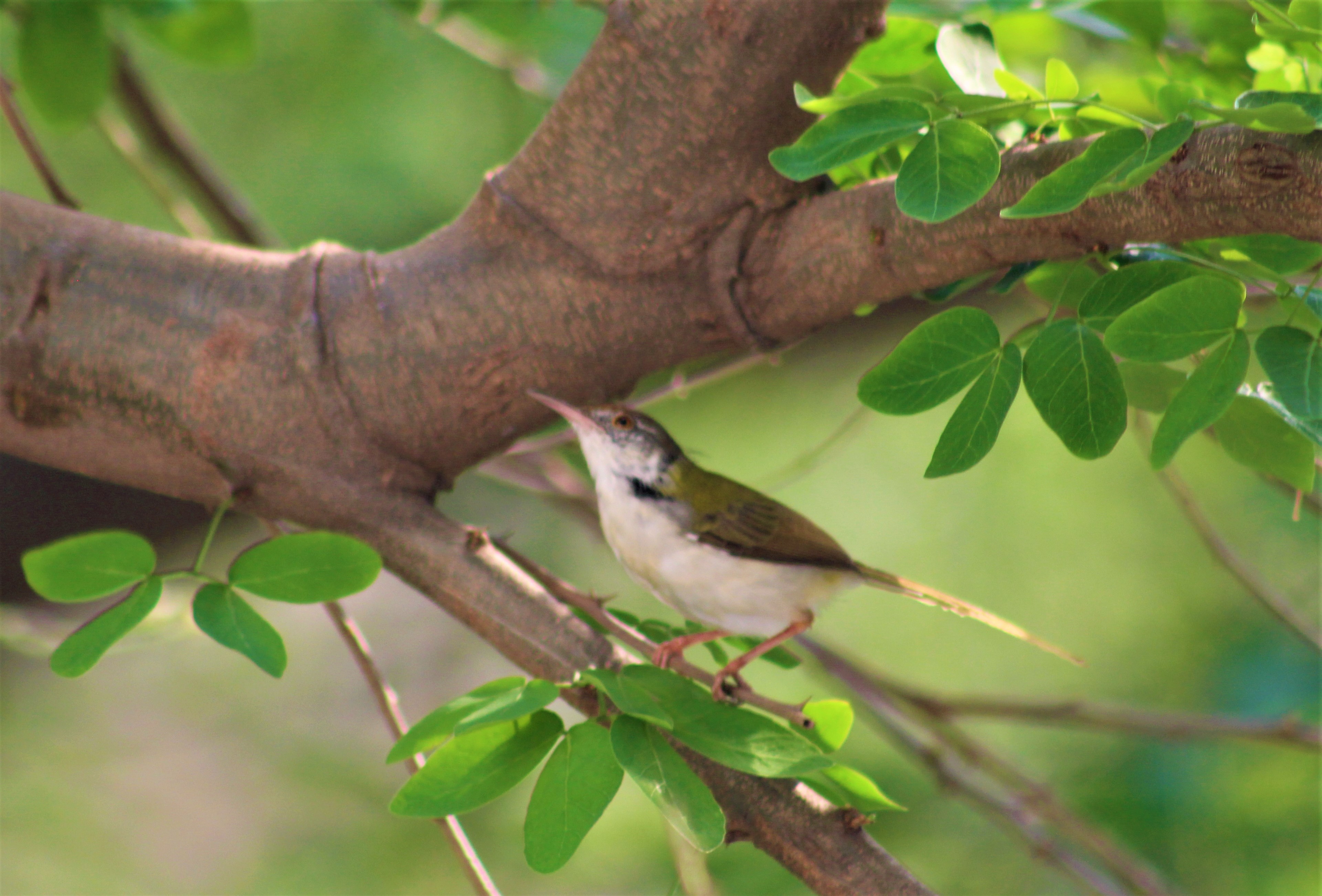
Dippers
Order: PasseriformesFamily: Cinclidae
Dippers are a group of perching birds whose habitat includes aquatic environments in the Americas, Europe and Asia. They are named for their bobbing or dipping movements. There are two species which have been recorded in India.
Leafbirds

Order: PasseriformesFamily: Chloropseidae
The leafbirds are small, bulbul-like birds. The males are brightly plumaged, usually in greens and yellows.
Flowerpeckers
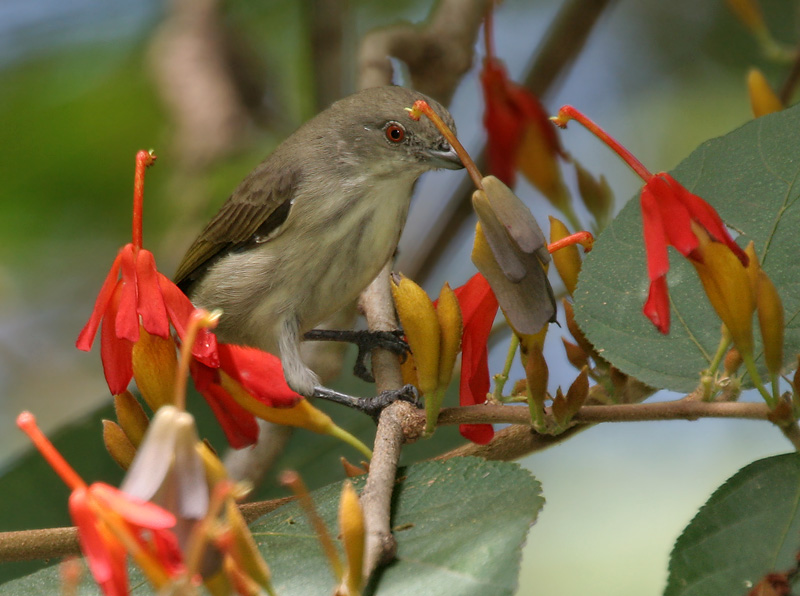
Order: PasseriformesFamily: Dicaeidae
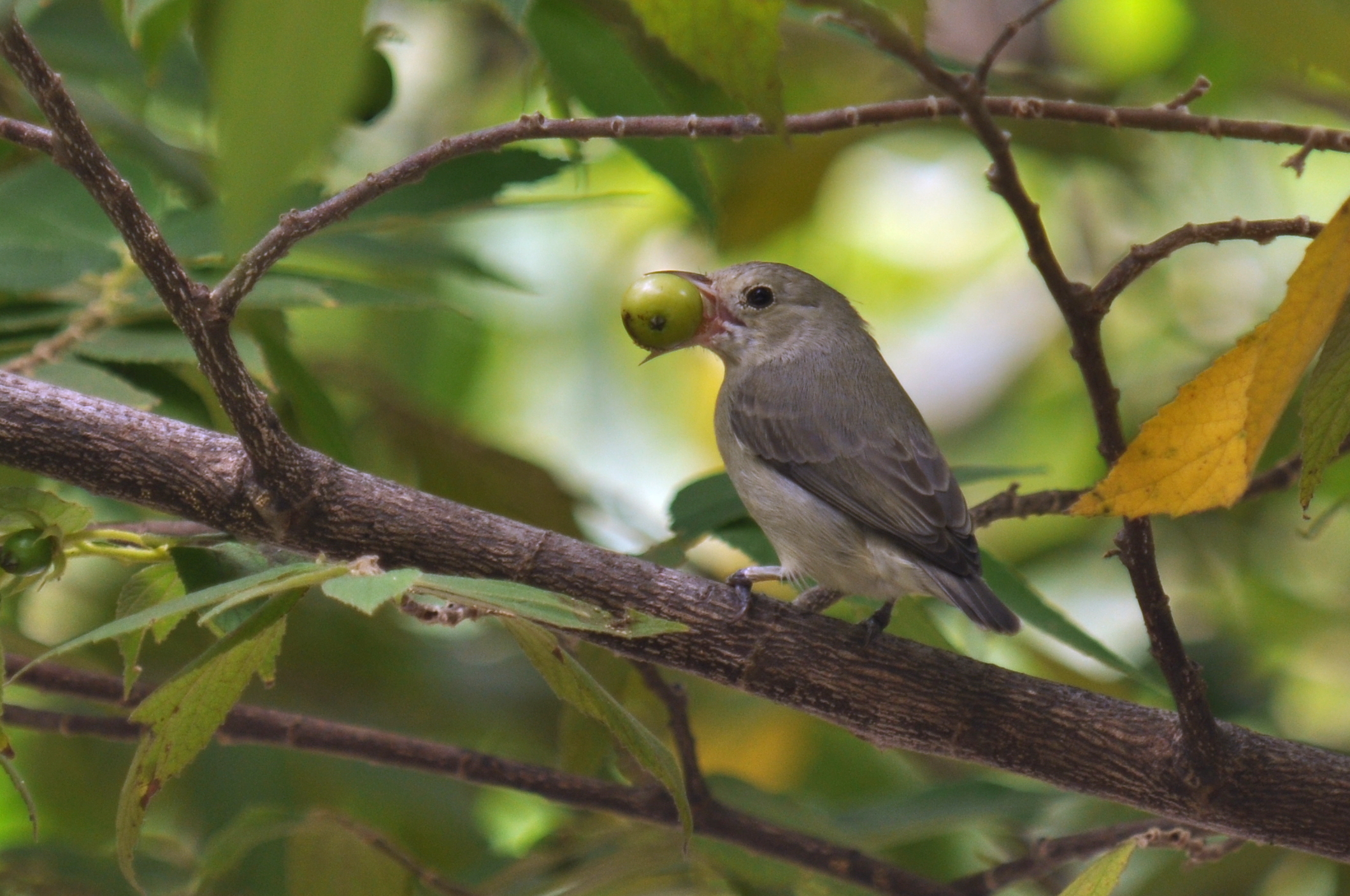
The flowerpeckers are very small, stout, often brightly coloured birds, with short tails, short thick curved bills and tubular tongues.
Sunbirds
Order: PasseriformesFamily: Nectariniidae

The sunbirds and spiderhunters are very small passerine birds which feed largely on nectar, although they will also take insects, especially when feeding young. Flight is fast and direct on their short wings. Most species can take nectar by hovering like a hummingbird, but usually perch to feed.
Old World sparrows and snowfinches
Order: PasseriformesFamily: Passeridae
Old World sparrow, Sparrows are small passerine birds. In general, sparrows tend to be small, plump, brown or grey birds with short tails and short powerful beaks. Sparrows are seed eaters, but they also consume small insects.

Weavers and widowbirds

Order: PasseriformesFamily: Ploceidae
The weavers are small passerine birds related to the finches. They are seed-eating birds with rounded conical bills. The males of many species are brightly coloured, usually in red or yellow and black, some species show variation in colour only in the breeding season. There are four species which have been recorded in India.
Waxbills, munias, and allies
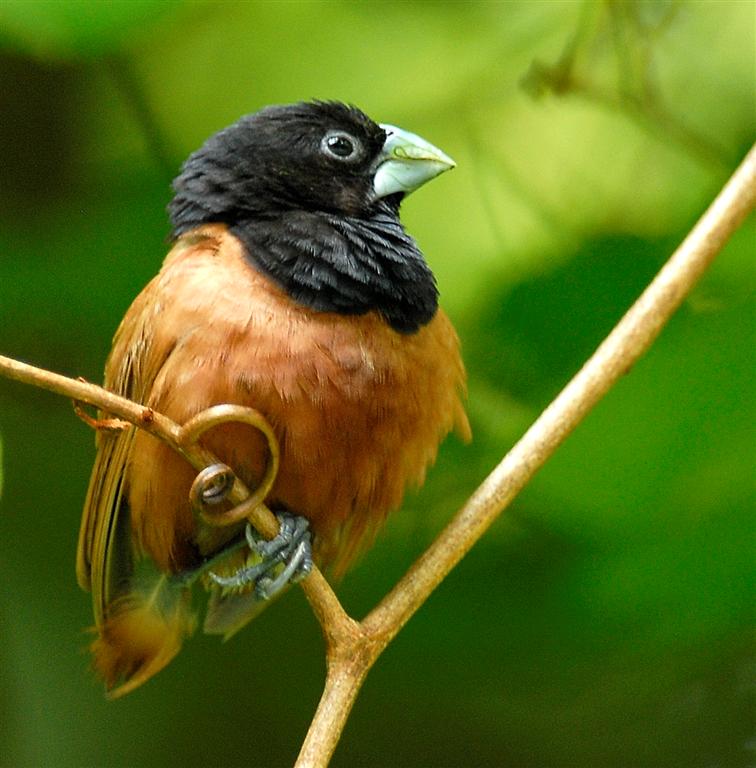
Order: PasseriformesFamily: Estrildidae

The estrildid finches are small passerine birds of the Old World tropics and Australasia. They are gregarious and often colonial seed eaters with short thick but pointed bills. They are all similar in structure and habits, but have wide variation in plumage colours and patterns.
Accentors

Order: PasseriformesFamily: Prunellidae
The accentors are in the only bird family, Prunellidae, which is completely endemic to the Palearctic. They are small, fairly drab species superficially similar to Old World sparrow, sparrows. There are seven species which have been recorded in India.
Wagtails and pipits
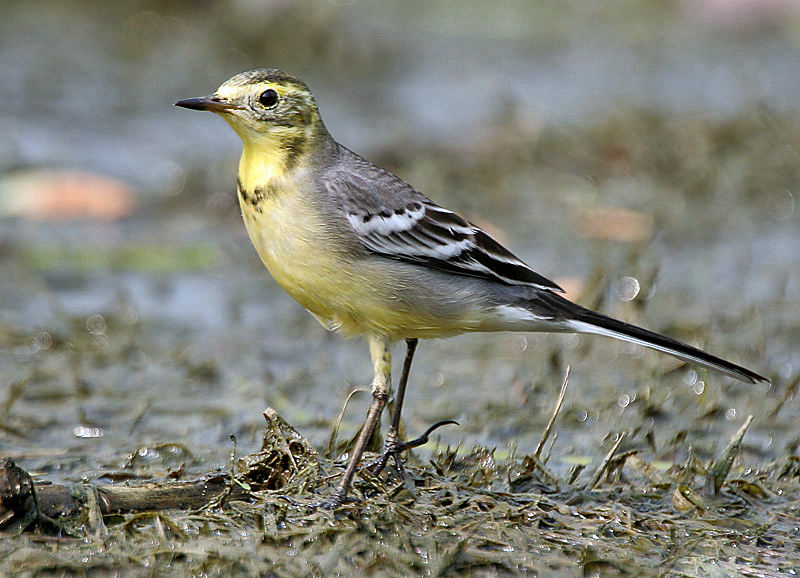
Order: PasseriformesFamily: Motacillidae

Motacillidae is a family of small passerine birds with medium to long tails. They include the wagtails, longclaws and pipits. They are slender, ground feeding insectivores of open country. There are 21 species which have been recorded in India.

Finches and euphonias

Order: PasseriformesFamily: Fringillidae
Finches are seed-eating passerine birds, that are small to moderately large and have a strong beak, usually conical and in some species very large. All have twelve tail feathers and nine primaries. These birds have a bouncing flight with alternating bouts of flapping and gliding on closed wings, and most sing well. There are 44 species which have been recorded in India.
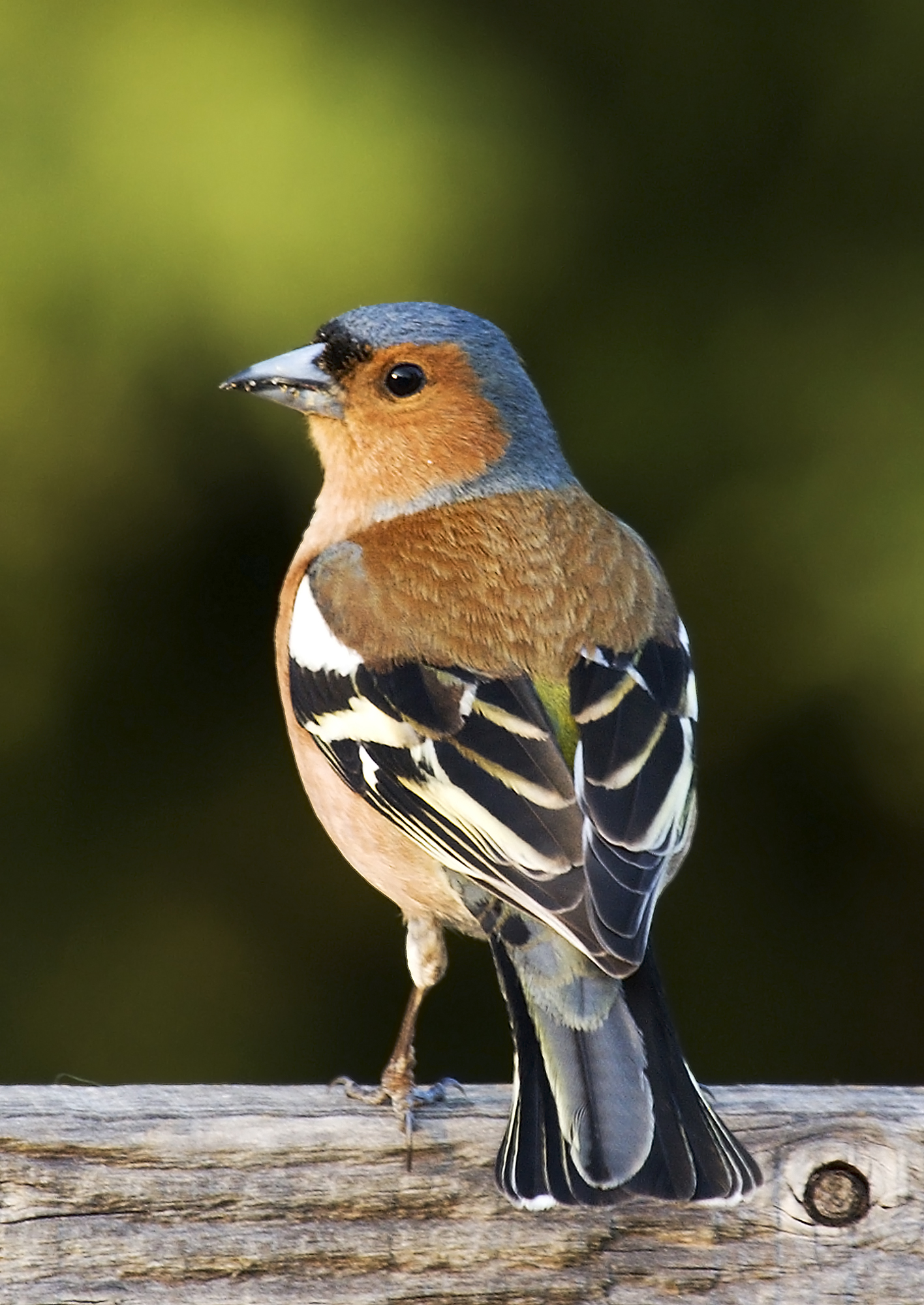
Buntings
Order: PasseriformesFamily: Emberizidae
The emberizids are a large family of passerine birds. They are seed-eating birds with distinctively shaped bills. Many emberizid species have distinctive head patterns.

See also
*List of Indian state birds
*Birds of the Central Indian Highlands
* Lists of birds by region
References
Other sources
*
*
{{Asia topic, List of birds of , title=List of birds of Asia, Birds of Asia
Lists of birds of Asia, India
Lists of birds of India,
Lists of fauna of India, birds




 Order:
Order:  The Phasianidae are a family of terrestrial birds which consists of
The Phasianidae are a family of terrestrial birds which consists of  Order:
Order: 
 Order:
Order: 
 Order: OtidiformesFamily:
Order: OtidiformesFamily: 

 Order:
Order: 


 Order:
Order: 
 Cranes are large, long-legged and long-necked birds. Unlike the similar-looking but unrelated herons, cranes fly with necks outstretched, not pulled back. Most have elaborate and noisy courting displays or "dances". There are five species which have been recorded in India.
The
Cranes are large, long-legged and long-necked birds. Unlike the similar-looking but unrelated herons, cranes fly with necks outstretched, not pulled back. Most have elaborate and noisy courting displays or "dances". There are five species which have been recorded in India.
The  Order: PodicipediformesFamily: Podicipedidae
Order: PodicipediformesFamily: Podicipedidae
 Order:
Order: 
 Stone-curlews are a group of largely tropical waders in the family Burhinidae. They are found worldwide within the tropical zone, with some species also breeding in temperate Europe and Australia. They are medium to large waders with strong black or yellow-black bills, large yellow eyes and
Stone-curlews are a group of largely tropical waders in the family Burhinidae. They are found worldwide within the tropical zone, with some species also breeding in temperate Europe and Australia. They are medium to large waders with strong black or yellow-black bills, large yellow eyes and  Order:
Order: 
 Order:
Order:  Order:
Order: 


 Order:
Order:  Order:
Order: 


 Order:
Order:  Order: PhaethontiformesFamily: Phaethontidae
Tropicbirds are slender white birds of tropical oceans, with exceptionally long central tail feathers. Their heads and long wings have black markings.
Order: PhaethontiformesFamily: Phaethontidae
Tropicbirds are slender white birds of tropical oceans, with exceptionally long central tail feathers. Their heads and long wings have black markings.
 Order: ProcellariiformesFamily: Oceanitidae
The storm petrels are relatives of the petrels and are the smallest seabirds. They feed on planktonic crustaceans and small fish picked from the surface, typically while hovering. The flight is fluttering and sometimes bat-like.
Order: ProcellariiformesFamily: Oceanitidae
The storm petrels are relatives of the petrels and are the smallest seabirds. They feed on planktonic crustaceans and small fish picked from the surface, typically while hovering. The flight is fluttering and sometimes bat-like.

 Order: CiconiiformesFamily: Ciconiidae
Storks are large, long-legged, long-necked, wading birds with long, stout bills. Storks are mute, but bill-clattering is an important mode of communication at the nest. Their nests can be large and may be reused for many years. Many species are migratory.
Order: CiconiiformesFamily: Ciconiidae
Storks are large, long-legged, long-necked, wading birds with long, stout bills. Storks are mute, but bill-clattering is an important mode of communication at the nest. Their nests can be large and may be reused for many years. Many species are migratory.
 Order: SuliformesFamily: Fregatidae
Frigatebirds are large seabirds usually found over tropical oceans. They are large, black-and-white or completely black, with long wings and deeply forked tails. The males have coloured inflatable throat pouches. They do not swim or walk and cannot take off from a flat surface. Having the largest wingspan-to-body-weight ratio of any bird, they are essentially aerial, able to stay aloft for more than a week.
Order: SuliformesFamily: Fregatidae
Frigatebirds are large seabirds usually found over tropical oceans. They are large, black-and-white or completely black, with long wings and deeply forked tails. The males have coloured inflatable throat pouches. They do not swim or walk and cannot take off from a flat surface. Having the largest wingspan-to-body-weight ratio of any bird, they are essentially aerial, able to stay aloft for more than a week.
 Order: SuliformesFamily: Sulidae
The sulids comprise the gannets and Booby, boobies. Both groups are medium to large coastal seabirds that plunge-dive for fish.
Order: SuliformesFamily: Sulidae
The sulids comprise the gannets and Booby, boobies. Both groups are medium to large coastal seabirds that plunge-dive for fish.
 Order: SuliformesFamily: Anhingidae
Darters are often called "snake-birds" because of their long thin neck, which gives a snake-like appearance when they swim with their bodies submerged. The males have black and dark-brown plumage, an erectile crest on the nape and a larger bill than the female. The females have much paler plumage especially on the neck and underparts. The darters have completely webbed feet and their legs are short and set far back on the body. Their plumage is somewhat permeable, like that of cormorants, and they spread their wings to dry after diving.
Order: SuliformesFamily: Anhingidae
Darters are often called "snake-birds" because of their long thin neck, which gives a snake-like appearance when they swim with their bodies submerged. The males have black and dark-brown plumage, an erectile crest on the nape and a larger bill than the female. The females have much paler plumage especially on the neck and underparts. The darters have completely webbed feet and their legs are short and set far back on the body. Their plumage is somewhat permeable, like that of cormorants, and they spread their wings to dry after diving.
 Order: SuliformesFamily: Phalacrocoracidae
Phalacrocoracidae is a family of medium to large coastal, fish-eating seabirds that includes cormorants and shags. Plumage colouration varies, with the majority having mainly dark plumage, some species being black-and-white and a few being colourful.
Order: SuliformesFamily: Phalacrocoracidae
Phalacrocoracidae is a family of medium to large coastal, fish-eating seabirds that includes cormorants and shags. Plumage colouration varies, with the majority having mainly dark plumage, some species being black-and-white and a few being colourful.

 Order: PelecaniformesFamily: Threskiornithidae
Threskiornithidae is a family of large terrestrial and wading birds which includes the ibises and spoonbills. They have long, broad wings with 11 primary and about 20 secondary feathers. They are strong fliers and despite their size and weight, very capable soarers.
Order: PelecaniformesFamily: Threskiornithidae
Threskiornithidae is a family of large terrestrial and wading birds which includes the ibises and spoonbills. They have long, broad wings with 11 primary and about 20 secondary feathers. They are strong fliers and despite their size and weight, very capable soarers.
 Order: PelecaniformesFamily: Ardeidae
The family Ardeidae contains the bitterns, herons and egrets. Herons and egrets are medium to large wading birds with long necks and legs. Bitterns tend to be shorter necked and more wary. Members of Ardeidae fly with their necks retracted, unlike other long-necked birds such as storks, ibises and spoonbills.
Order: PelecaniformesFamily: Ardeidae
The family Ardeidae contains the bitterns, herons and egrets. Herons and egrets are medium to large wading birds with long necks and legs. Bitterns tend to be shorter necked and more wary. Members of Ardeidae fly with their necks retracted, unlike other long-necked birds such as storks, ibises and spoonbills.
 Order: PelecaniformesFamily: Pelecanidae
Pelicans are large water birds with a distinctive pouch under their beak. As with other members of the order Pelecaniformes, they have webbed feet with four toes. There are three species which have been recorded in India.
Order: PelecaniformesFamily: Pelecanidae
Pelicans are large water birds with a distinctive pouch under their beak. As with other members of the order Pelecaniformes, they have webbed feet with four toes. There are three species which have been recorded in India.
 Order: AccipitriformesFamily: Pandionidae
The family Pandionidae contains usually only one species, the osprey. The osprey is a medium-large bird of prey, raptor which is a specialist fish-eater with most taxonomic authorities consider a worldwide distribution.
Order: AccipitriformesFamily: Pandionidae
The family Pandionidae contains usually only one species, the osprey. The osprey is a medium-large bird of prey, raptor which is a specialist fish-eater with most taxonomic authorities consider a worldwide distribution.




 Order: AccipitriformesFamily: Accipitridae
Accipitridae is a family of birds of prey, which includes hawks, eagles, Kite (bird), kites, Harrier (bird), harriers and Old World vultures. These birds have powerful hooked beaks for tearing flesh from their prey, strong legs, powerful talons and keen eyesight.
Order: AccipitriformesFamily: Accipitridae
Accipitridae is a family of birds of prey, which includes hawks, eagles, Kite (bird), kites, Harrier (bird), harriers and Old World vultures. These birds have powerful hooked beaks for tearing flesh from their prey, strong legs, powerful talons and keen eyesight.
 Order: StrigiformesFamily: Tytonidae
Barn owls are medium to large owls with large heads and characteristic heart-shaped faces. They have long strong legs with powerful talons.
Order: StrigiformesFamily: Tytonidae
Barn owls are medium to large owls with large heads and characteristic heart-shaped faces. They have long strong legs with powerful talons.


 Order: BucerotiformesFamily: Upupidae
Hoopoes have black, white and orangey-pink colouring with a large erectile crest on their head. There is one species which occurs in India.
Order: BucerotiformesFamily: Upupidae
Hoopoes have black, white and orangey-pink colouring with a large erectile crest on their head. There is one species which occurs in India.

 Order: BucerotiformesFamily: Bucerotidae
Hornbills are a group of birds whose bill is shaped like a cow's horn, but without a twist, sometimes with a casque on the upper mandible. Frequently, the bill is brightly coloured.
Order: BucerotiformesFamily: Bucerotidae
Hornbills are a group of birds whose bill is shaped like a cow's horn, but without a twist, sometimes with a casque on the upper mandible. Frequently, the bill is brightly coloured.

 Order: CoraciiformesFamily: Coraciidae
Rollers resemble crows in size and build, but are more closely related to the kingfishers and bee-eaters. They share the colourful appearance of those groups with blues and browns predominating. The two inner front toes are connected at the base, but the outer toe is not. There are three or four species (depending on taxonomy followed) which have been recorded in India.
Order: CoraciiformesFamily: Coraciidae
Rollers resemble crows in size and build, but are more closely related to the kingfishers and bee-eaters. They share the colourful appearance of those groups with blues and browns predominating. The two inner front toes are connected at the base, but the outer toe is not. There are three or four species (depending on taxonomy followed) which have been recorded in India.

 Order: CoraciiformesFamily: Alcedinidae
Kingfishers are medium-sized birds with large heads, long, pointed bills, short legs and stubby tails. There are 13 species which have been recorded in India.
Order: CoraciiformesFamily: Alcedinidae
Kingfishers are medium-sized birds with large heads, long, pointed bills, short legs and stubby tails. There are 13 species which have been recorded in India.
 Order: CoraciiformesFamily: Meropidae
The bee-eaters are a group of near passerine birds in the family Meropidae. Most species are found in Africa but others occur in southern Europe, Madagascar, Australia and New Guinea. They are characterised by richly coloured plumage, slender bodies and usually elongated central tail feathers. All are colourful and have long downturned bills and pointed wings, which give them a swallow-like appearance when seen from afar. There are 7 species which have been recorded in India.
Order: CoraciiformesFamily: Meropidae
The bee-eaters are a group of near passerine birds in the family Meropidae. Most species are found in Africa but others occur in southern Europe, Madagascar, Australia and New Guinea. They are characterised by richly coloured plumage, slender bodies and usually elongated central tail feathers. All are colourful and have long downturned bills and pointed wings, which give them a swallow-like appearance when seen from afar. There are 7 species which have been recorded in India.

 Order: PiciformesFamily: Megalaimidae
The Asian barbets are plump birds, with short necks and large heads. They get their name from the bristles which fringe their heavy bills. Most species are brightly coloured.
Order: PiciformesFamily: Megalaimidae
The Asian barbets are plump birds, with short necks and large heads. They get their name from the bristles which fringe their heavy bills. Most species are brightly coloured.
 Order: PiciformesFamily: Picidae
Woodpeckers are small to medium-sized birds with chisel-like beaks, short legs, stiff tails and long tongues used for capturing insects. Some species have feet with two toes pointing forward and two backward, while several species have only three toes. Many woodpeckers have the habit of tapping noisily on tree trunks with their beaks.
Order: PiciformesFamily: Picidae
Woodpeckers are small to medium-sized birds with chisel-like beaks, short legs, stiff tails and long tongues used for capturing insects. Some species have feet with two toes pointing forward and two backward, while several species have only three toes. Many woodpeckers have the habit of tapping noisily on tree trunks with their beaks.


 Order: FalconiformesFamily: Falconidae
Falconidae is a family of diurnal birds of prey. They differ from hawks, eagles and kites in that they kill with their beaks instead of their talons. There are thirteen species which have been recorded in India.
Order: FalconiformesFamily: Falconidae
Falconidae is a family of diurnal birds of prey. They differ from hawks, eagles and kites in that they kill with their beaks instead of their talons. There are thirteen species which have been recorded in India.
 Order: PsittaciformesFamily: Psittaculidae
Characteristic features of parrots include a strong curved bill, an upright stance, strong legs, and clawed zygodactyl feet. Many parrots are vividly coloured, and some are multi-coloured. In size they range from to in length. Old World parrots are found from Africa east across south and southeast Asia and Oceania to Australia and New Zealand.
Order: PsittaciformesFamily: Psittaculidae
Characteristic features of parrots include a strong curved bill, an upright stance, strong legs, and clawed zygodactyl feet. Many parrots are vividly coloured, and some are multi-coloured. In size they range from to in length. Old World parrots are found from Africa east across south and southeast Asia and Oceania to Australia and New Zealand.
 Order: PasseriformesFamily: Eurylaimidae
The broadbills are small, brightly coloured birds, which feed on fruit and also take insects in flycatcher fashion, snapping their broad bills. Their habitat is canopies of wet forests. There are two species which have been recorded in India.
Order: PasseriformesFamily: Eurylaimidae
The broadbills are small, brightly coloured birds, which feed on fruit and also take insects in flycatcher fashion, snapping their broad bills. Their habitat is canopies of wet forests. There are two species which have been recorded in India.
 Order: PasseriformesFamily: Pittidae
Pittas are medium-sized by passerine standards and are stocky, with fairly long, strong legs, short tails and stout bills. Many are brightly coloured. They spend the majority of their time on wet forest floors, eating snails, insects and similar invertebrates.
Order: PasseriformesFamily: Pittidae
Pittas are medium-sized by passerine standards and are stocky, with fairly long, strong legs, short tails and stout bills. Many are brightly coloured. They spend the majority of their time on wet forest floors, eating snails, insects and similar invertebrates.
 Order: PasseriformesFamily: Vangidae
The woodshrikes are similar in build to the shrikes.
Order: PasseriformesFamily: Vangidae
The woodshrikes are similar in build to the shrikes.
 Order: PasseriformesFamily: Aegithinidae
The ioras are bulbul-like birds of open forest or thorn scrub, but whereas that group tends to be drab in colouration, ioras are sexually dimorphic, with the males being brightly plumaged in yellows and greens. There are two species which have been recorded in India.
Order: PasseriformesFamily: Aegithinidae
The ioras are bulbul-like birds of open forest or thorn scrub, but whereas that group tends to be drab in colouration, ioras are sexually dimorphic, with the males being brightly plumaged in yellows and greens. There are two species which have been recorded in India.

 Order: PasseriformesFamily: Campephagidae
The cuckooshrikes are small to medium-sized passerine birds. They are predominantly greyish with white and black, although some species are brightly coloured. There are 14 species which have been recorded in India.
Order: PasseriformesFamily: Campephagidae
The cuckooshrikes are small to medium-sized passerine birds. They are predominantly greyish with white and black, although some species are brightly coloured. There are 14 species which have been recorded in India.
 Order: PasseriformesFamily: Pachycephalidae
The family Pachycephalidae includes the whistlers, shrikethrushes, and some of the pitohuis. There is one species which occurs in India.
Order: PasseriformesFamily: Pachycephalidae
The family Pachycephalidae includes the whistlers, shrikethrushes, and some of the pitohuis. There is one species which occurs in India.
 Order: PasseriformesFamily: Laniidae
Shrikes are passerine birds known for their habit of catching other birds and small animals and impaling the uneaten portions of their bodies on thorns. A typical shrike's beak is hooked, like a bird of prey.
Order: PasseriformesFamily: Laniidae
Shrikes are passerine birds known for their habit of catching other birds and small animals and impaling the uneaten portions of their bodies on thorns. A typical shrike's beak is hooked, like a bird of prey. Order: PasseriformesFamily: Vireonidae
Most of the members of this family are found in the New World. However, the shrike-babblers and erpornis, which only slightly resemble the "true" vireos and greenlets, are found in South East Asia.
Order: PasseriformesFamily: Vireonidae
Most of the members of this family are found in the New World. However, the shrike-babblers and erpornis, which only slightly resemble the "true" vireos and greenlets, are found in South East Asia.
 Order: PasseriformesFamily: Oriolidae
The Old World orioles are colourful passerine birds. They are not related to the New World orioles. There are six species which have been recorded in India.
Order: PasseriformesFamily: Oriolidae
The Old World orioles are colourful passerine birds. They are not related to the New World orioles. There are six species which have been recorded in India.
 Order: PasseriformesFamily: Dicruridae
The drongos are mostly black or dark grey in colour, sometimes with metallic tints. They have long forked tails, and some Asian species have elaborate tail decorations. They have short legs and sit very upright when perched, like a shrike. They flycatch or take prey from the ground. There are ten species which have been recorded in India.
Order: PasseriformesFamily: Dicruridae
The drongos are mostly black or dark grey in colour, sometimes with metallic tints. They have long forked tails, and some Asian species have elaborate tail decorations. They have short legs and sit very upright when perched, like a shrike. They flycatch or take prey from the ground. There are ten species which have been recorded in India.
 Order: PasseriformesFamily: Monarchidae
The monarch flycatchers are small to medium-sized insectivorous passerines which hunt by flycatching. There are four species which have been recorded in India.
Order: PasseriformesFamily: Monarchidae
The monarch flycatchers are small to medium-sized insectivorous passerines which hunt by flycatching. There are four species which have been recorded in India.

 Order: PasseriformesFamily: Corvidae
The family Corvidae includes crows, ravens, jays, choughs, magpies, treepies, nutcracker (bird), nutcrackers and ground jays. Corvids are above average in size among the Passeriformes, and some of the larger species show high levels of intelligence.
Order: PasseriformesFamily: Corvidae
The family Corvidae includes crows, ravens, jays, choughs, magpies, treepies, nutcracker (bird), nutcrackers and ground jays. Corvids are above average in size among the Passeriformes, and some of the larger species show high levels of intelligence.

 Order: PasseriformesFamily: Bombycillidae
The waxwings are a group of birds with soft silky plumage and unique red tips to some of the wing feathers. In the Bohemian and cedar waxwings, these tips look like sealing wax and give the group its name. These are arboreal birds of northern forests. They live on insects in summer and berries in winter. There is one species which occurs in India.
Order: PasseriformesFamily: Bombycillidae
The waxwings are a group of birds with soft silky plumage and unique red tips to some of the wing feathers. In the Bohemian and cedar waxwings, these tips look like sealing wax and give the group its name. These are arboreal birds of northern forests. They live on insects in summer and berries in winter. There is one species which occurs in India.
 Order: PasseriformesFamily: Stenostiridae
Most of the species of this small family are found in Africa, though a few inhabit tropical Asia. They are not closely related to other birds called "flycatchers".
Order: PasseriformesFamily: Stenostiridae
Most of the species of this small family are found in Africa, though a few inhabit tropical Asia. They are not closely related to other birds called "flycatchers".

 Order: PasseriformesFamily: Paridae
The Paridae are mainly small stocky woodland species with short stout bills. Some have crests. They are adaptable birds, with a mixed diet including seeds and insects.
Order: PasseriformesFamily: Paridae
The Paridae are mainly small stocky woodland species with short stout bills. Some have crests. They are adaptable birds, with a mixed diet including seeds and insects.
 Order: PasseriformesFamily: Alaudidae
Order: PasseriformesFamily: Alaudidae
 Larks are small terrestrial birds with often extravagant songs and display flights. Most larks are fairly dull in appearance. Their food is insects and seeds.
Larks are small terrestrial birds with often extravagant songs and display flights. Most larks are fairly dull in appearance. Their food is insects and seeds.

 Order: PasseriformesFamily: Pycnonotidae
Order: PasseriformesFamily: Pycnonotidae
 Bulbuls are medium-sized songbirds. Some are colourful with yellow, red or orange vents, cheeks, throats or supercilia, but most are drab, with uniform olive-brown to black plumage. Some species have distinct crests.
Bulbuls are medium-sized songbirds. Some are colourful with yellow, red or orange vents, cheeks, throats or supercilia, but most are drab, with uniform olive-brown to black plumage. Some species have distinct crests.

 Order: PasseriformesFamily: Hirundinidae
The family Hirundinidae is adapted to aerial feeding. They have a slender streamlined body, long pointed wings and a short bill with a wide gape. The feet are adapted to perching rather than walking, and the front toes are partially joined at the base.
Order: PasseriformesFamily: Hirundinidae
The family Hirundinidae is adapted to aerial feeding. They have a slender streamlined body, long pointed wings and a short bill with a wide gape. The feet are adapted to perching rather than walking, and the front toes are partially joined at the base.

 Order: PasseriformesFamily: Cettiidae
Cettiidae is a family of small insectivorous songbirds. It contains the typical bush warblers (Cettia) and their relatives. Its members occur mainly in Asia and Africa, ranging into Oceania and Europe.
Order: PasseriformesFamily: Cettiidae
Cettiidae is a family of small insectivorous songbirds. It contains the typical bush warblers (Cettia) and their relatives. Its members occur mainly in Asia and Africa, ranging into Oceania and Europe.
 Order: PasseriformesFamily: Aegithalidae
Long-tailed tits are a group of small passerine birds with medium to long tails. They make woven bag nests in trees. Most eat a mixed diet which includes insects.
Order: PasseriformesFamily: Aegithalidae
Long-tailed tits are a group of small passerine birds with medium to long tails. They make woven bag nests in trees. Most eat a mixed diet which includes insects.
 Leaf warblers are a family of small insectivorous birds found mostly in Eurasia and ranging into Wallacea and Africa. The species are of various sizes, often green-plumaged above and yellow below, or more subdued with grayish-green to grayish-brown colors.
Leaf warblers are a family of small insectivorous birds found mostly in Eurasia and ranging into Wallacea and Africa. The species are of various sizes, often green-plumaged above and yellow below, or more subdued with grayish-green to grayish-brown colors.
 Order: PasseriformesFamily: Locustellidae
Order: PasseriformesFamily: Locustellidae
 Locustellidae are a family of small insectivorous songbirds found mainly in Eurasia, Africa, and the Australian region. They are smallish birds with tails that are usually long and pointed, and tend to be drab brownish or buffy all over.
Locustellidae are a family of small insectivorous songbirds found mainly in Eurasia, Africa, and the Australian region. They are smallish birds with tails that are usually long and pointed, and tend to be drab brownish or buffy all over.
 Order: PasseriformesFamily: Cisticolidae
The Cisticolidae are warblers found mainly in warmer southern regions of the Old World. They are generally very small birds of drab brown or grey appearance found in open country such as grassland or scrub.
Order: PasseriformesFamily: Cisticolidae
The Cisticolidae are warblers found mainly in warmer southern regions of the Old World. They are generally very small birds of drab brown or grey appearance found in open country such as grassland or scrub.

 Order: PasseriformesFamily: Sylviidae
The family Sylviidae is a group of small insectivorous passerine birds. They mainly occur as breeding species, as the common name implies, in Europe, Asia and, to a lesser extent, Africa. Many species are difficult to identify by appearance, but many have distinctive songs.
Order: PasseriformesFamily: Sylviidae
The family Sylviidae is a group of small insectivorous passerine birds. They mainly occur as breeding species, as the common name implies, in Europe, Asia and, to a lesser extent, Africa. Many species are difficult to identify by appearance, but many have distinctive songs.
 Order: PasseriformesFamily: Paradoxornithidae
The parrotbills are a group of peculiar birds which are diverse along the Himalayas east into Southeast Asia, though feral populations exist elsewhere. They are generally small, long-tailed birds which inhabit reedbeds and similar habitat. They feed mainly on seeds, e.g. of grasses, to which their bill, as the name implies, is well-adapted.
Order: PasseriformesFamily: Paradoxornithidae
The parrotbills are a group of peculiar birds which are diverse along the Himalayas east into Southeast Asia, though feral populations exist elsewhere. They are generally small, long-tailed birds which inhabit reedbeds and similar habitat. They feed mainly on seeds, e.g. of grasses, to which their bill, as the name implies, is well-adapted.
 The babblers, or timaliids, are somewhat diverse in size and colouration, but are characterised by soft fluffy plumage.
The babblers, or timaliids, are somewhat diverse in size and colouration, but are characterised by soft fluffy plumage.

 Order: PasseriformesFamily: Alcippeidae
The genus once included many other fulvettas and was previously placed in families Pellorneidae or Timaliidae.
Order: PasseriformesFamily: Alcippeidae
The genus once included many other fulvettas and was previously placed in families Pellorneidae or Timaliidae.


 The members of this family are diverse in size and colouration, though those of genus ''Turdoides'' tend to be brown or greyish. The family is found in Africa, India, and southeast Asia.
The members of this family are diverse in size and colouration, though those of genus ''Turdoides'' tend to be brown or greyish. The family is found in Africa, India, and southeast Asia.



 Order: PasseriformesFamily: Turdidae
The Thrush (bird), thrushes are a group of passerine birds that occur mainly in the Old World. They are plump, soft plumaged, small to medium-sized insectivores or sometimes omnivores, often feeding on the ground. Many have attractive songs.
Order: PasseriformesFamily: Turdidae
The Thrush (bird), thrushes are a group of passerine birds that occur mainly in the Old World. They are plump, soft plumaged, small to medium-sized insectivores or sometimes omnivores, often feeding on the ground. Many have attractive songs.








 Order: PasseriformesFamily: Chloropseidae
The leafbirds are small, bulbul-like birds. The males are brightly plumaged, usually in greens and yellows.
Order: PasseriformesFamily: Chloropseidae
The leafbirds are small, bulbul-like birds. The males are brightly plumaged, usually in greens and yellows.
 Order: PasseriformesFamily: Dicaeidae
Order: PasseriformesFamily: Dicaeidae
 The flowerpeckers are very small, stout, often brightly coloured birds, with short tails, short thick curved bills and tubular tongues.
The flowerpeckers are very small, stout, often brightly coloured birds, with short tails, short thick curved bills and tubular tongues.
 The sunbirds and spiderhunters are very small passerine birds which feed largely on nectar, although they will also take insects, especially when feeding young. Flight is fast and direct on their short wings. Most species can take nectar by hovering like a hummingbird, but usually perch to feed.
The sunbirds and spiderhunters are very small passerine birds which feed largely on nectar, although they will also take insects, especially when feeding young. Flight is fast and direct on their short wings. Most species can take nectar by hovering like a hummingbird, but usually perch to feed.

 Order: PasseriformesFamily: Ploceidae
The weavers are small passerine birds related to the finches. They are seed-eating birds with rounded conical bills. The males of many species are brightly coloured, usually in red or yellow and black, some species show variation in colour only in the breeding season. There are four species which have been recorded in India.
Order: PasseriformesFamily: Ploceidae
The weavers are small passerine birds related to the finches. They are seed-eating birds with rounded conical bills. The males of many species are brightly coloured, usually in red or yellow and black, some species show variation in colour only in the breeding season. There are four species which have been recorded in India.
 Order: PasseriformesFamily: Estrildidae
Order: PasseriformesFamily: Estrildidae
 The estrildid finches are small passerine birds of the Old World tropics and Australasia. They are gregarious and often colonial seed eaters with short thick but pointed bills. They are all similar in structure and habits, but have wide variation in plumage colours and patterns.
The estrildid finches are small passerine birds of the Old World tropics and Australasia. They are gregarious and often colonial seed eaters with short thick but pointed bills. They are all similar in structure and habits, but have wide variation in plumage colours and patterns.
 Order: PasseriformesFamily: Prunellidae
The accentors are in the only bird family, Prunellidae, which is completely endemic to the Palearctic. They are small, fairly drab species superficially similar to Old World sparrow, sparrows. There are seven species which have been recorded in India.
Order: PasseriformesFamily: Prunellidae
The accentors are in the only bird family, Prunellidae, which is completely endemic to the Palearctic. They are small, fairly drab species superficially similar to Old World sparrow, sparrows. There are seven species which have been recorded in India.
 Order: PasseriformesFamily: Motacillidae
Order: PasseriformesFamily: Motacillidae
 Motacillidae is a family of small passerine birds with medium to long tails. They include the wagtails, longclaws and pipits. They are slender, ground feeding insectivores of open country. There are 21 species which have been recorded in India.
Motacillidae is a family of small passerine birds with medium to long tails. They include the wagtails, longclaws and pipits. They are slender, ground feeding insectivores of open country. There are 21 species which have been recorded in India.
 Order: PasseriformesFamily: Fringillidae
Finches are seed-eating passerine birds, that are small to moderately large and have a strong beak, usually conical and in some species very large. All have twelve tail feathers and nine primaries. These birds have a bouncing flight with alternating bouts of flapping and gliding on closed wings, and most sing well. There are 44 species which have been recorded in India.
Order: PasseriformesFamily: Fringillidae
Finches are seed-eating passerine birds, that are small to moderately large and have a strong beak, usually conical and in some species very large. All have twelve tail feathers and nine primaries. These birds have a bouncing flight with alternating bouts of flapping and gliding on closed wings, and most sing well. There are 44 species which have been recorded in India.
